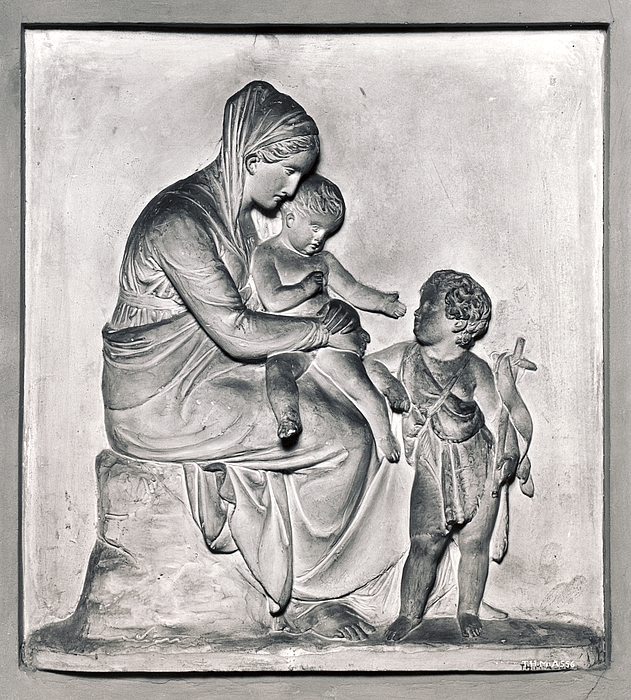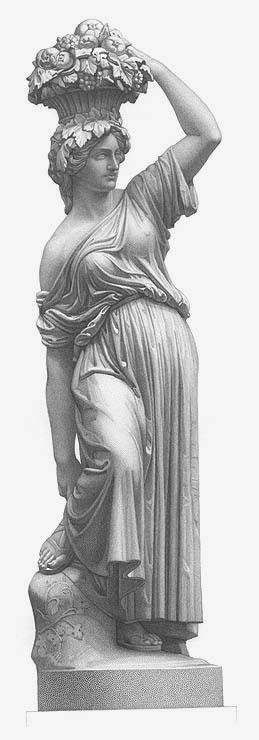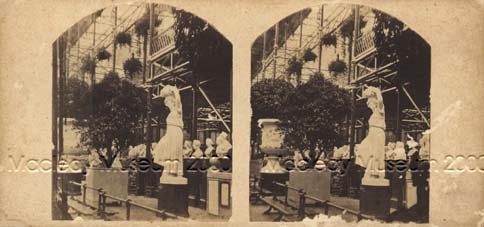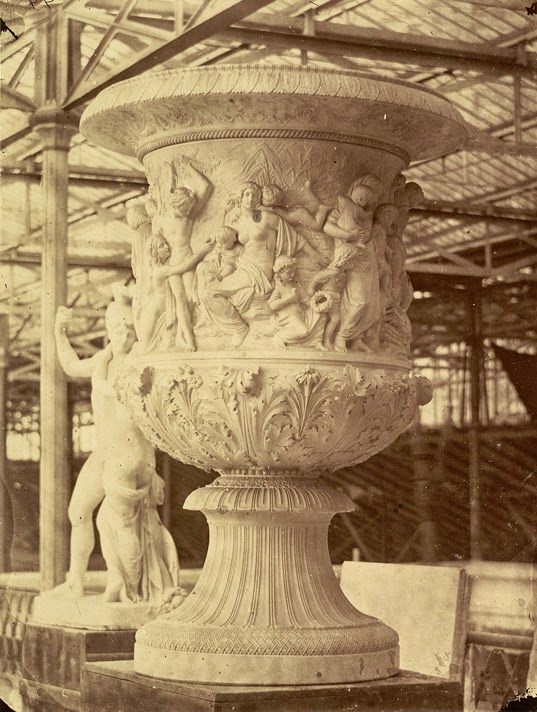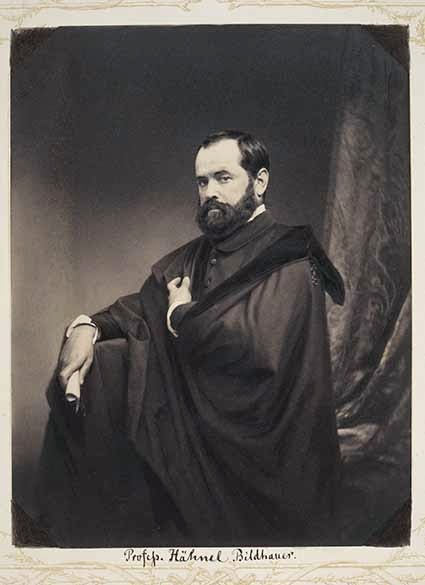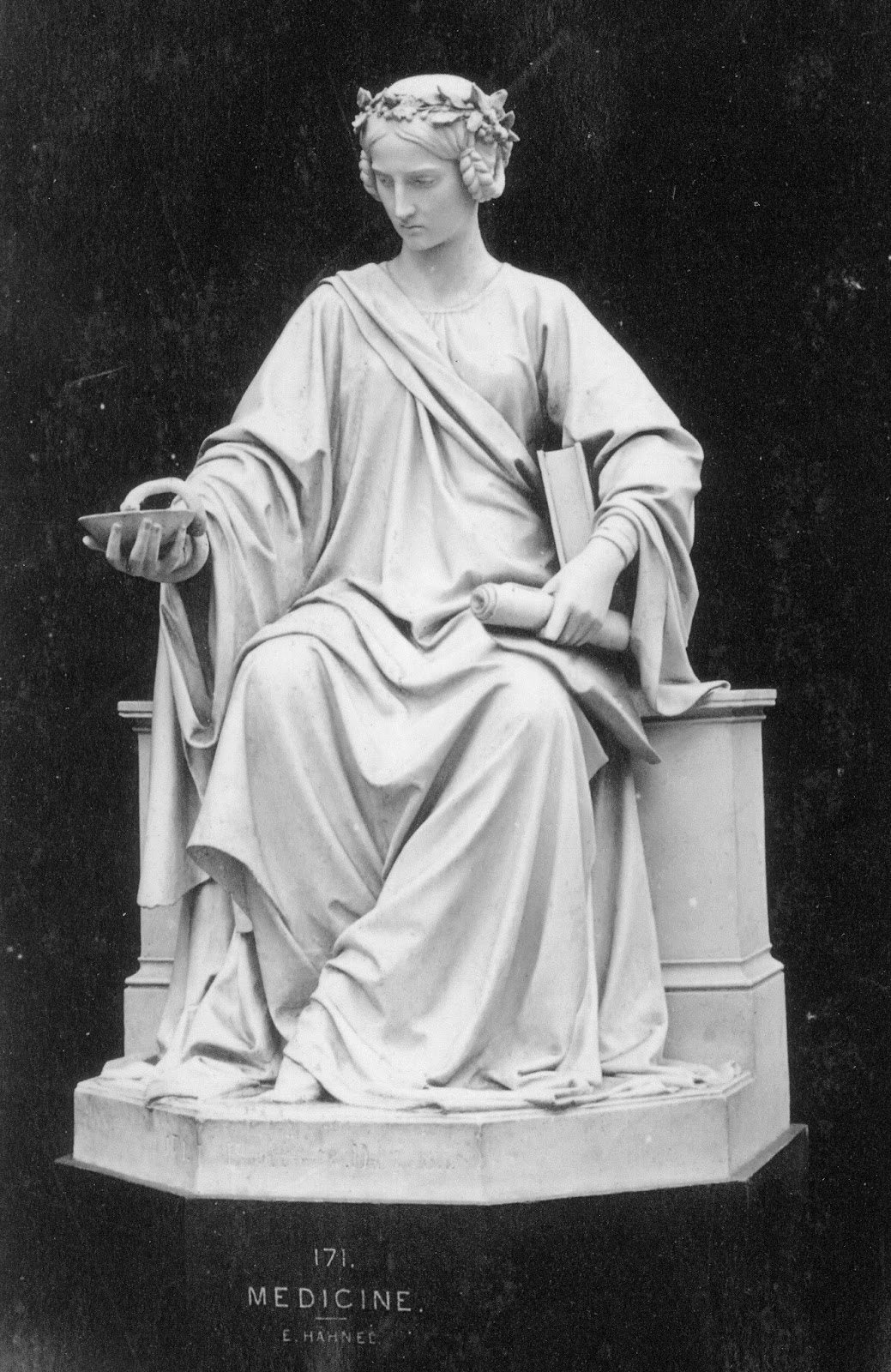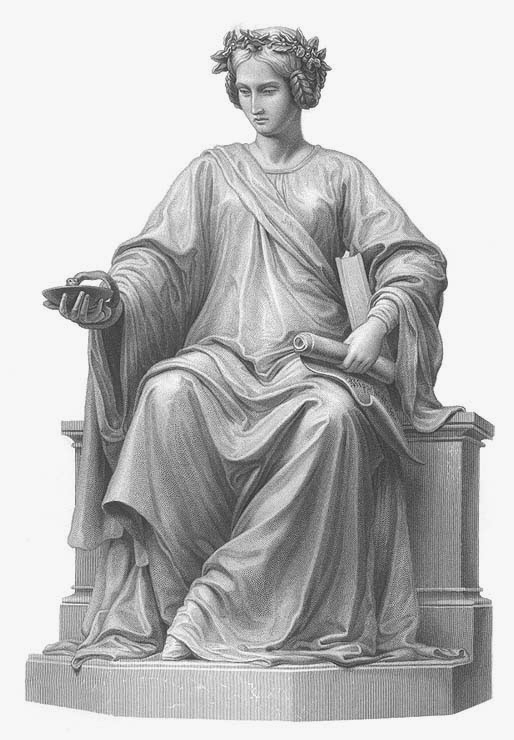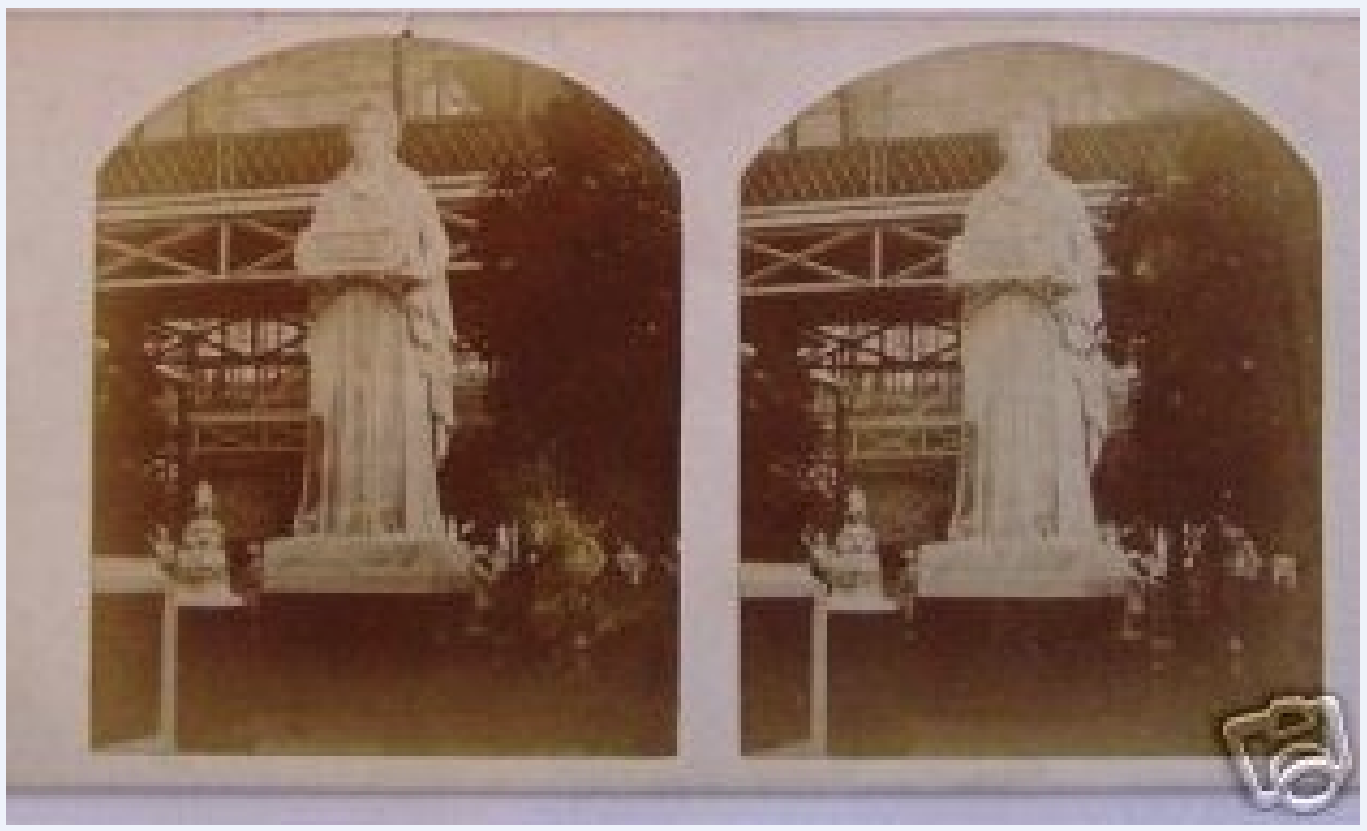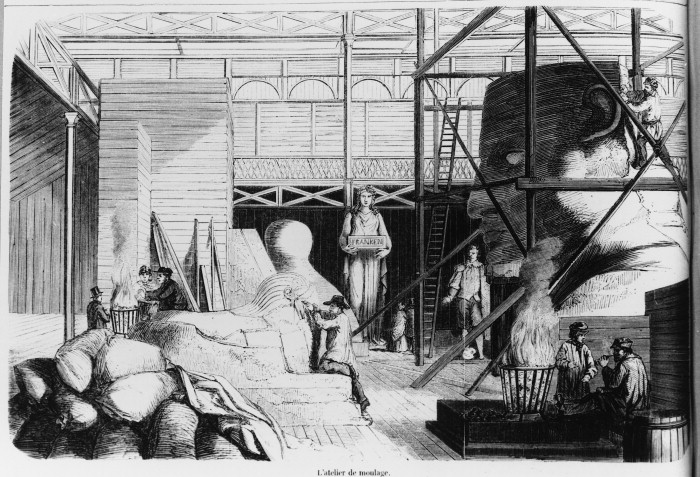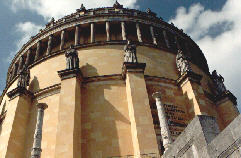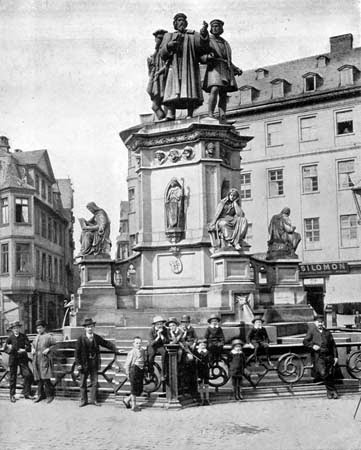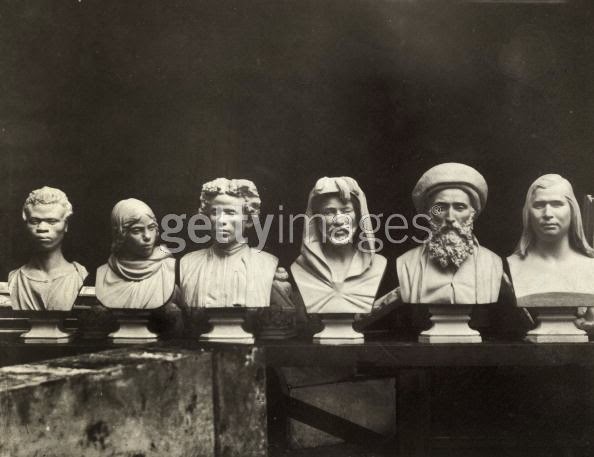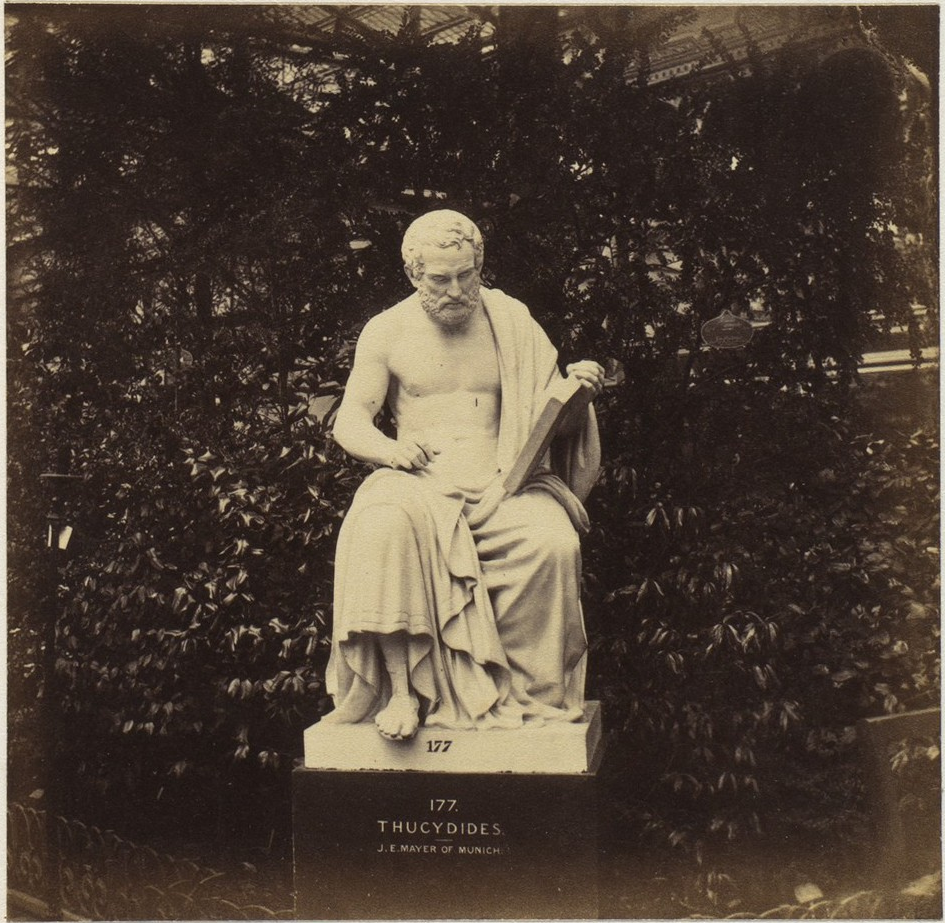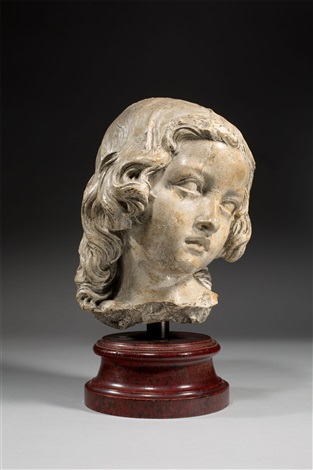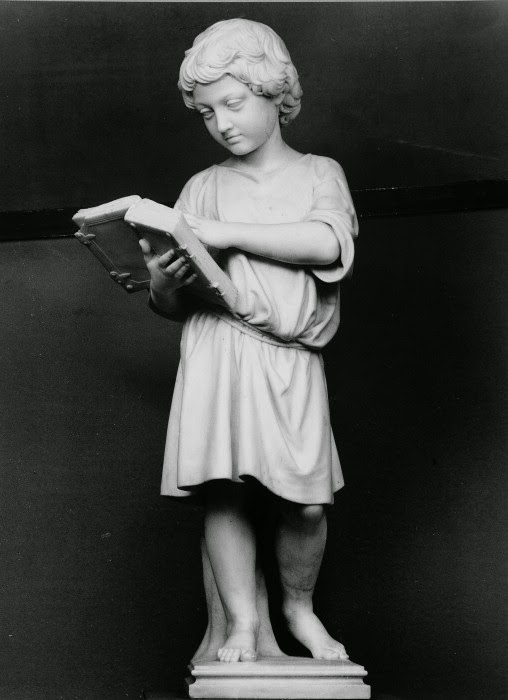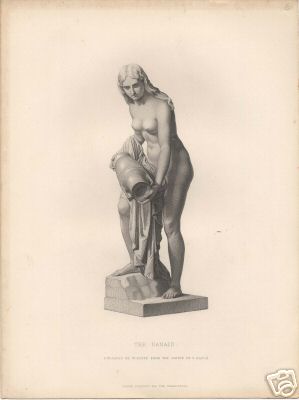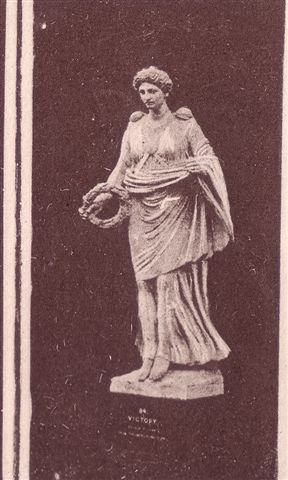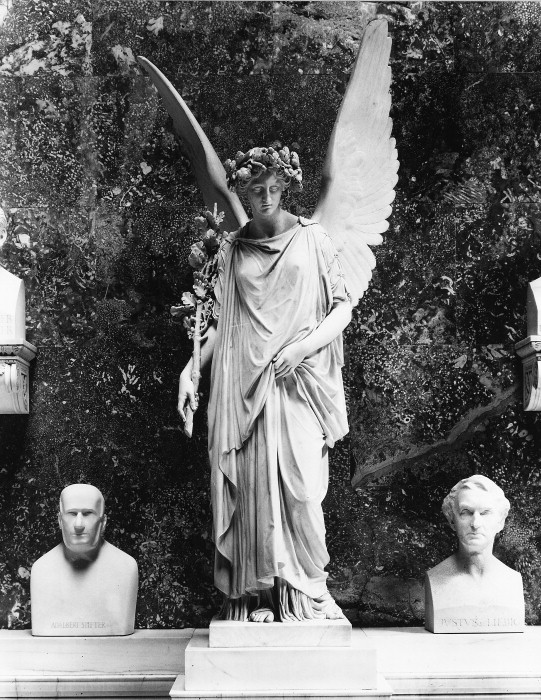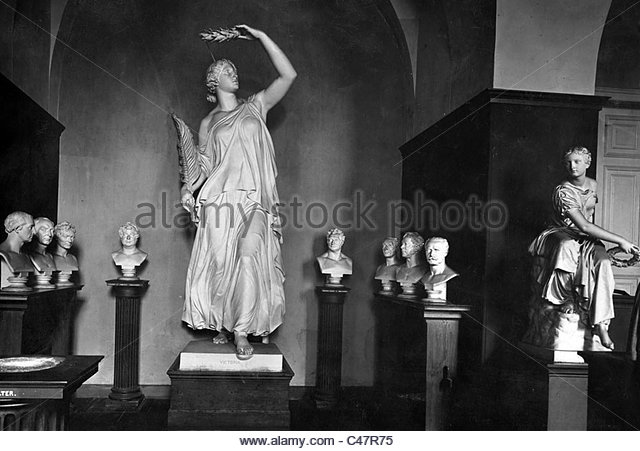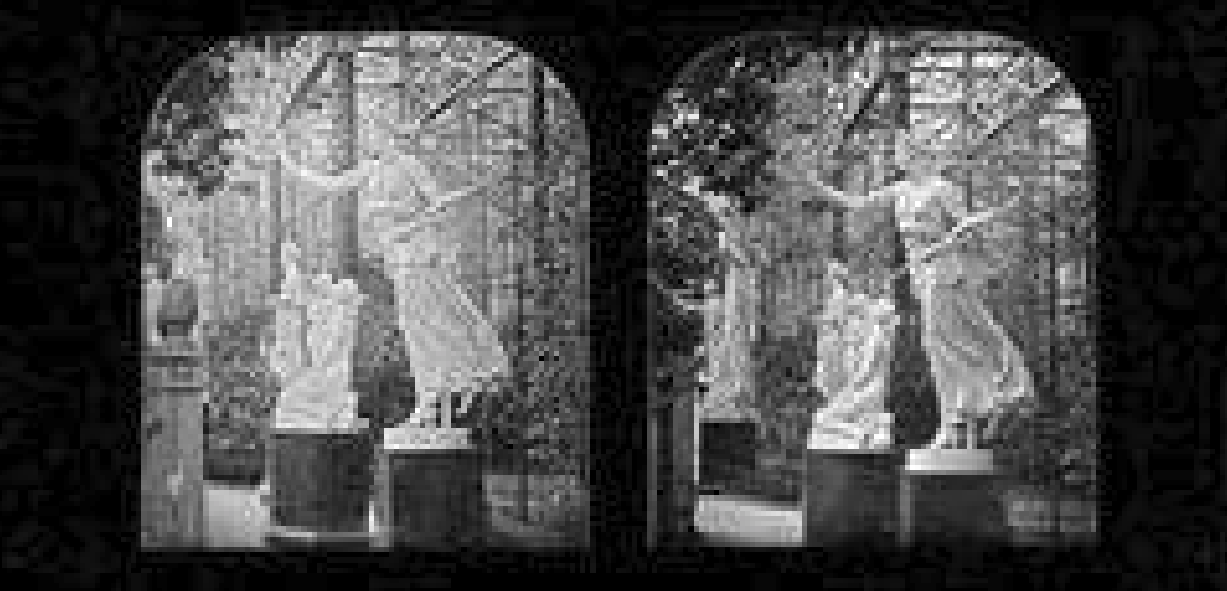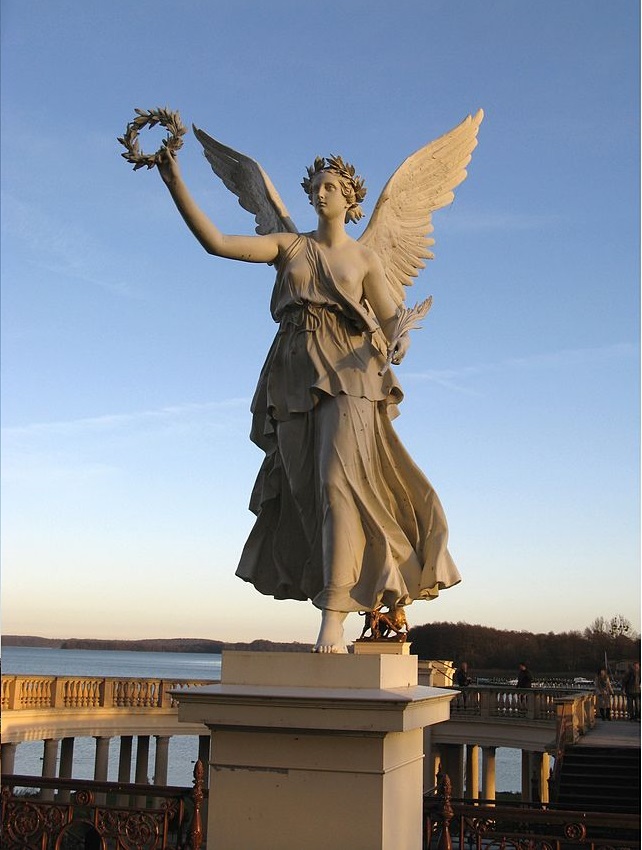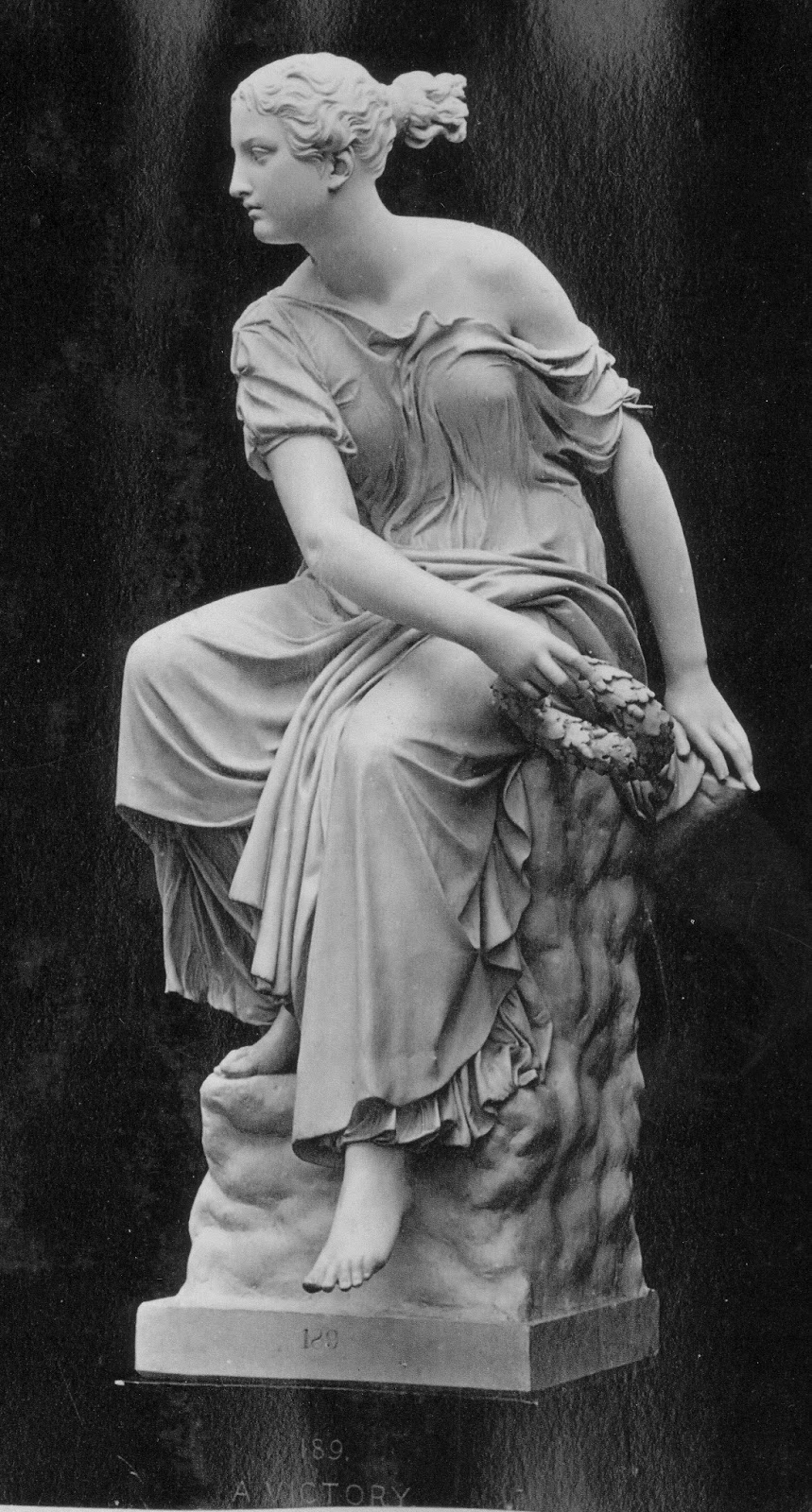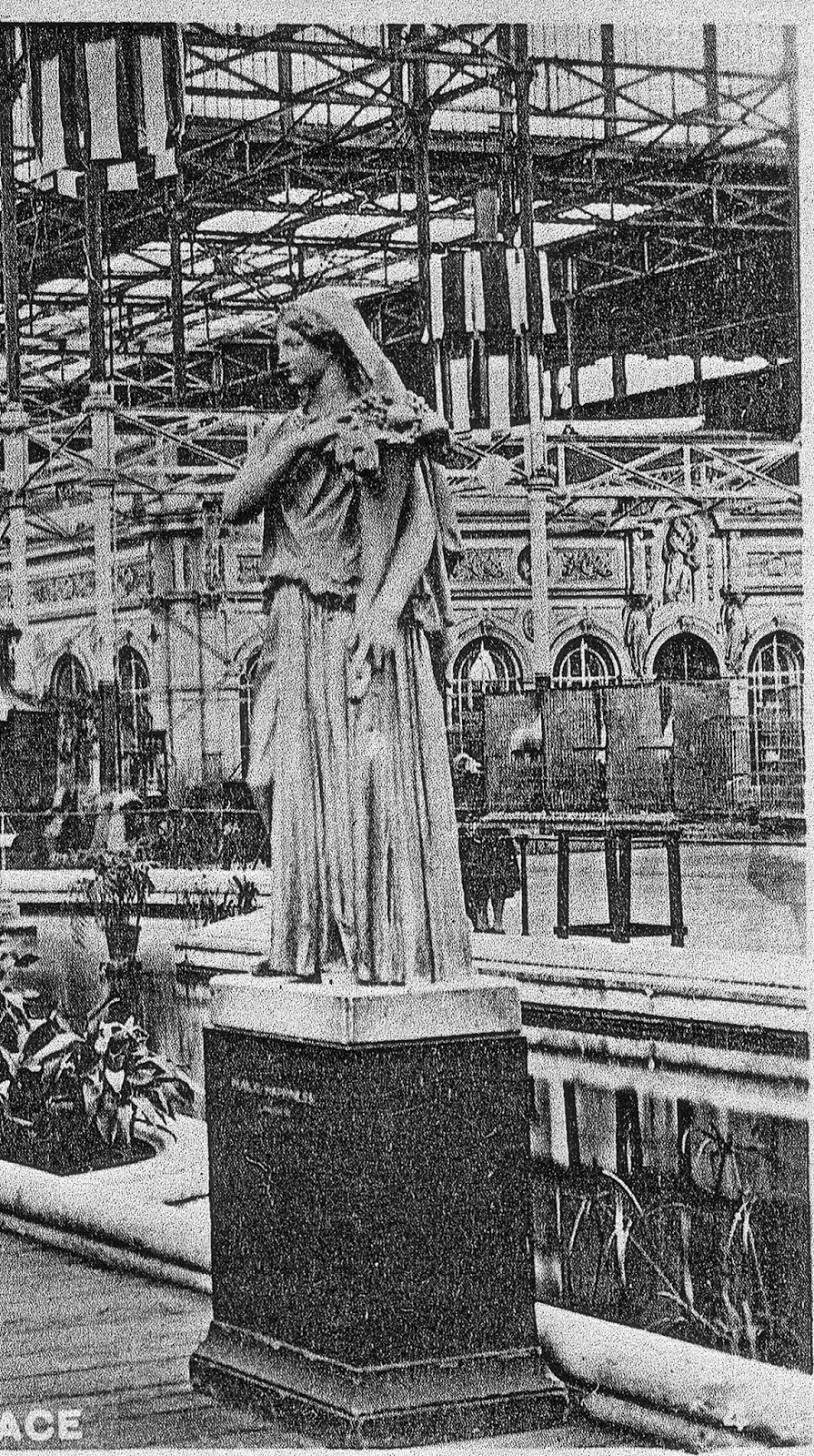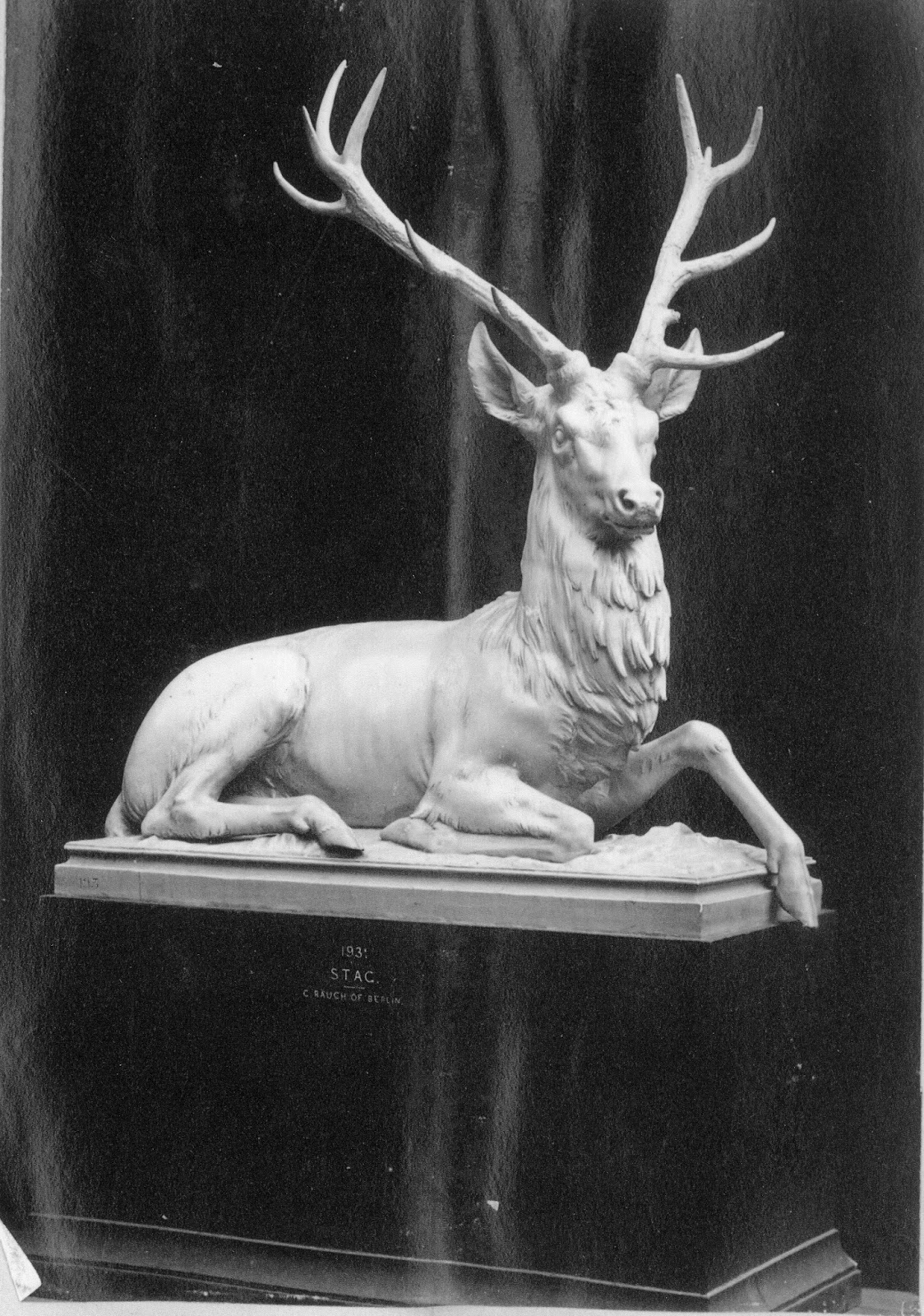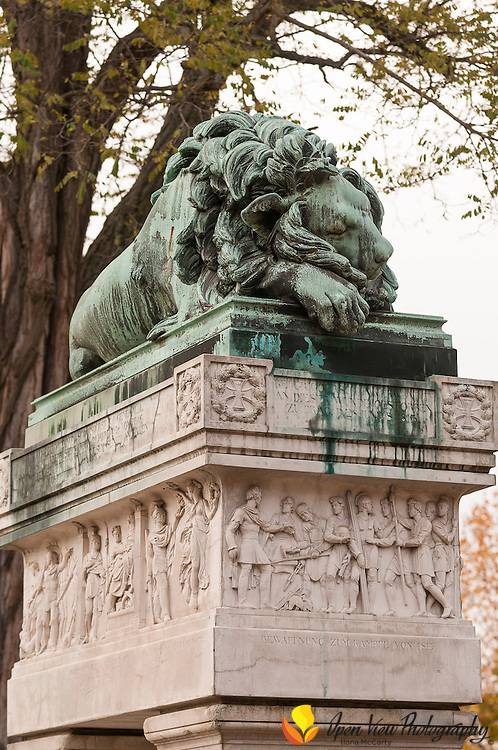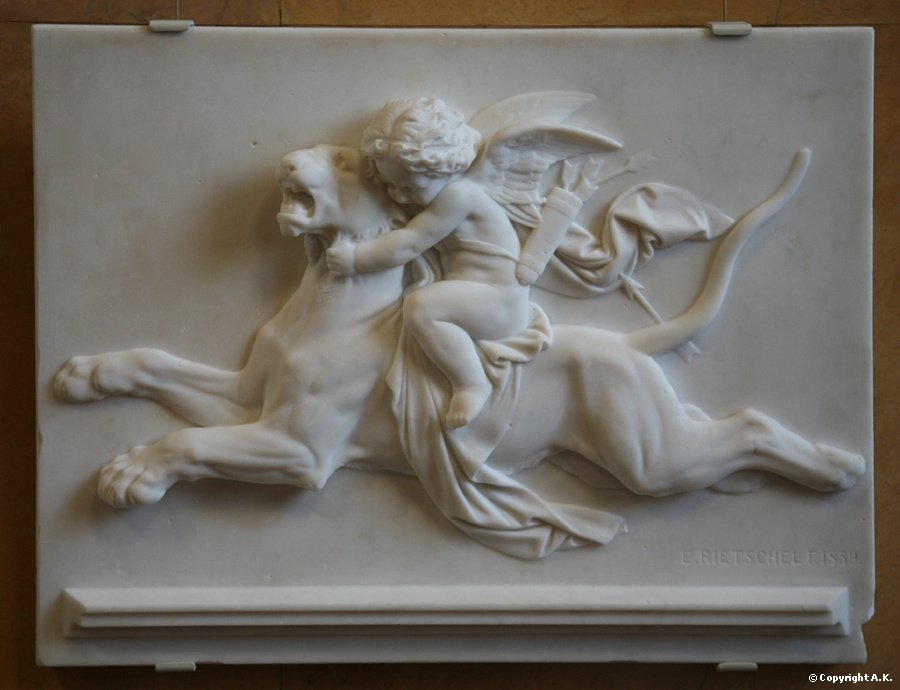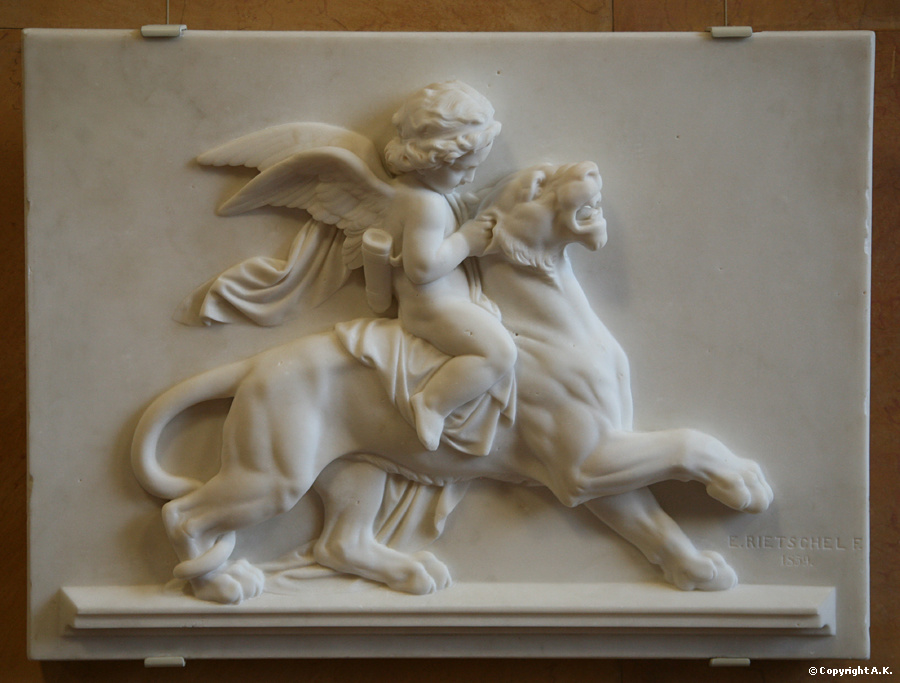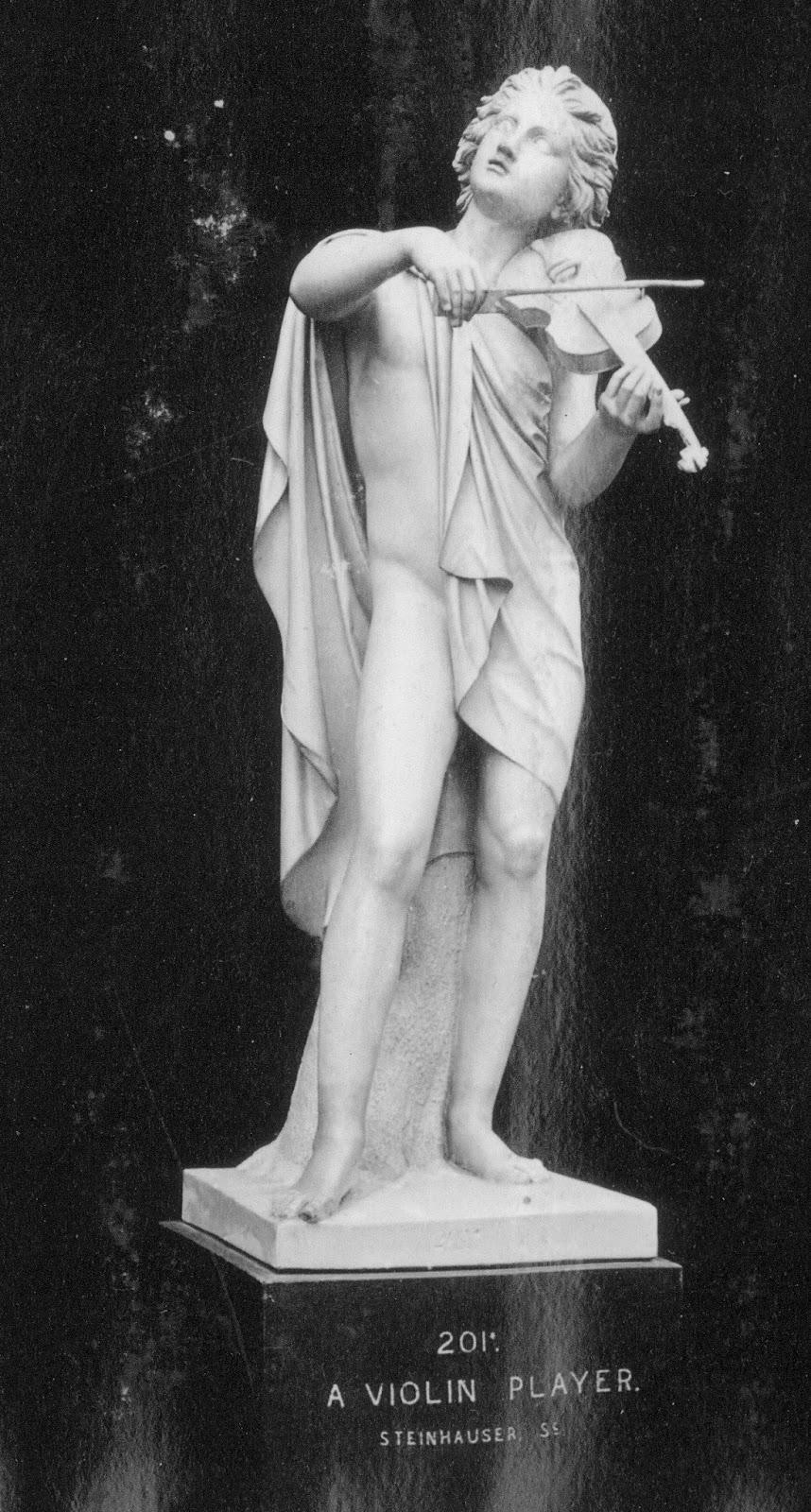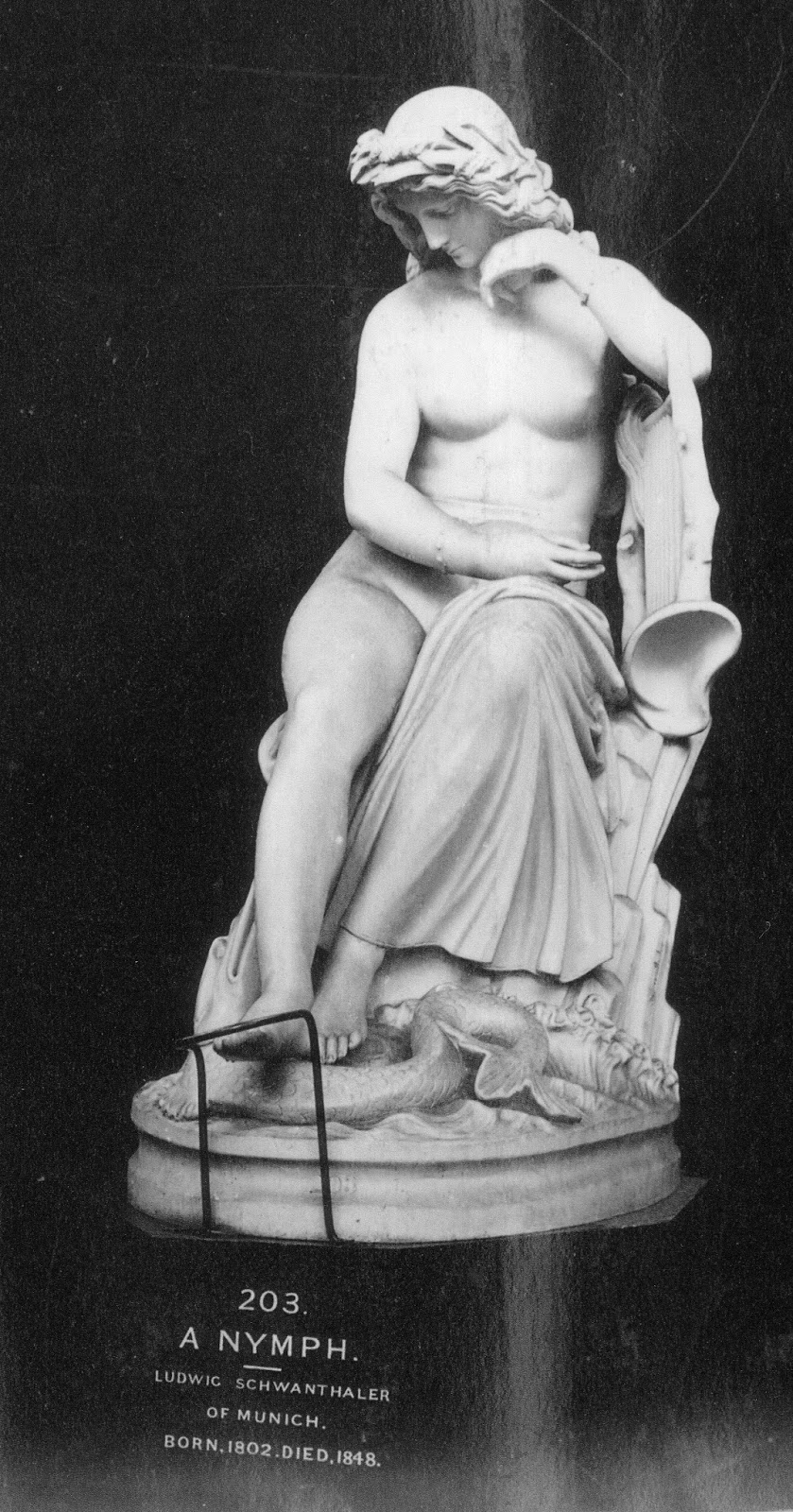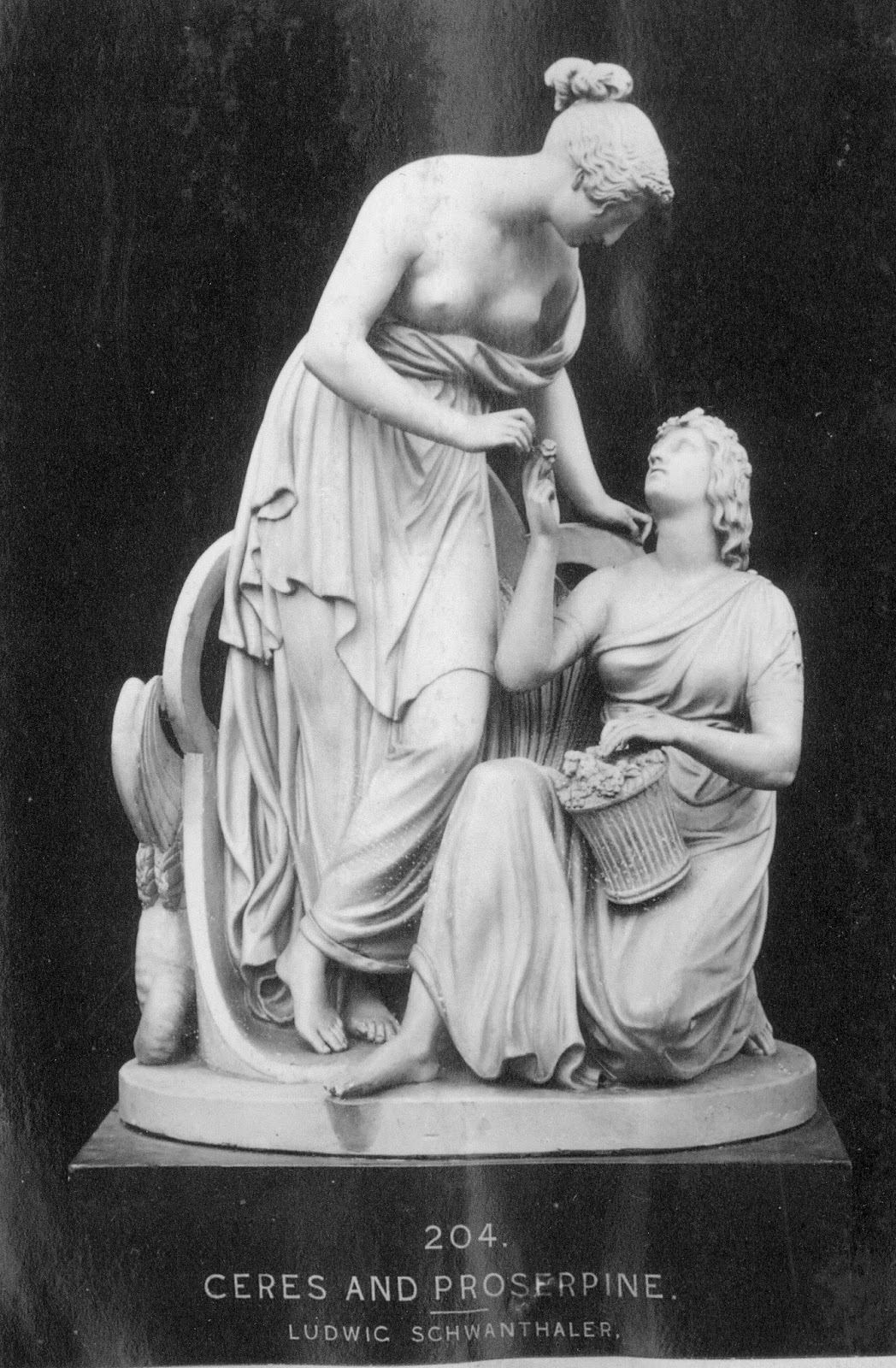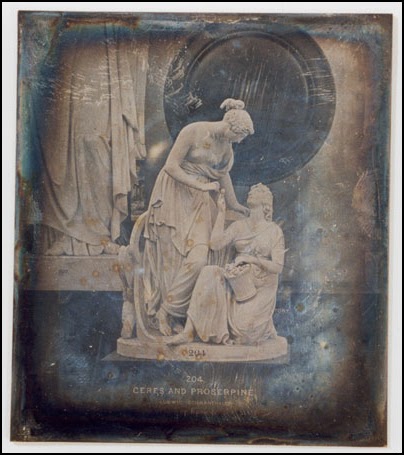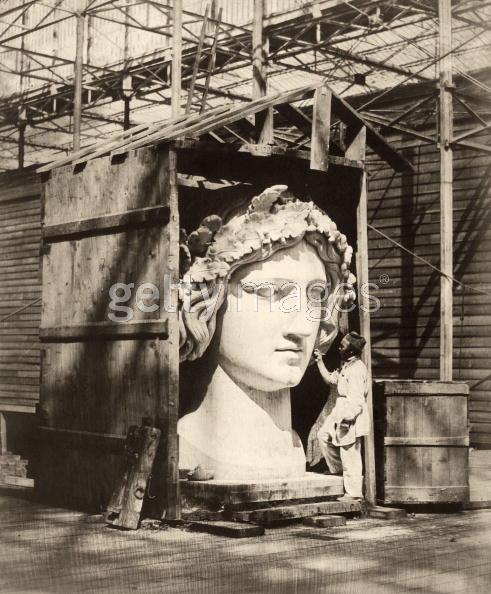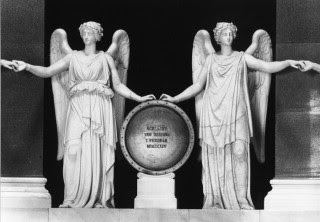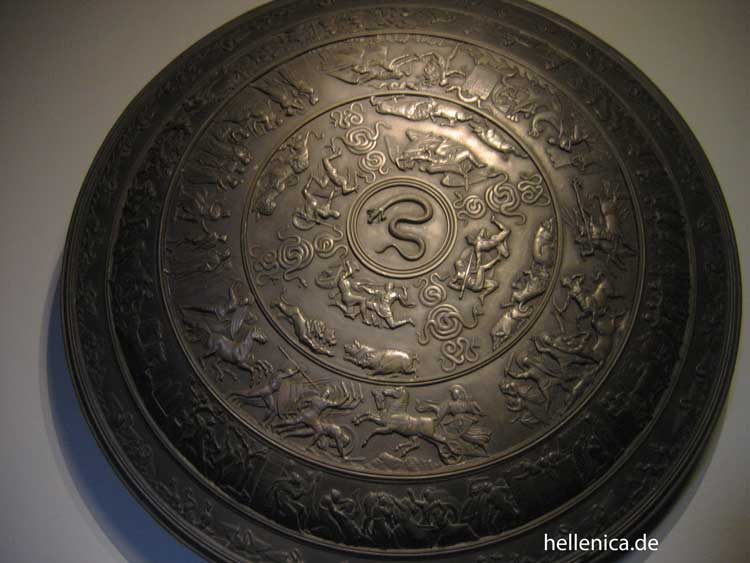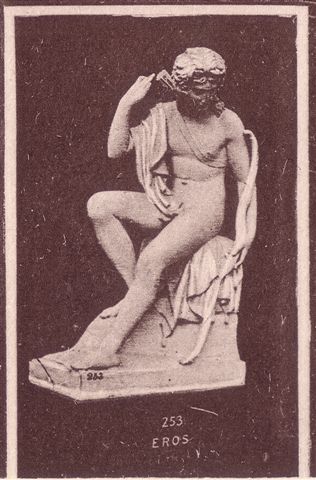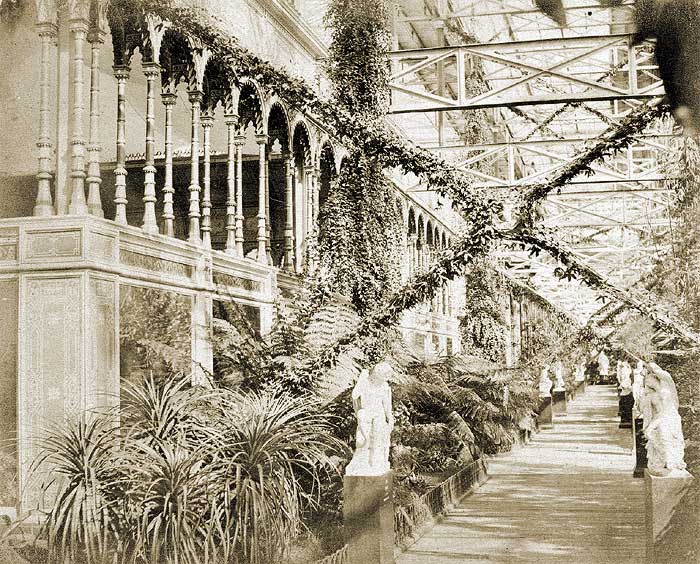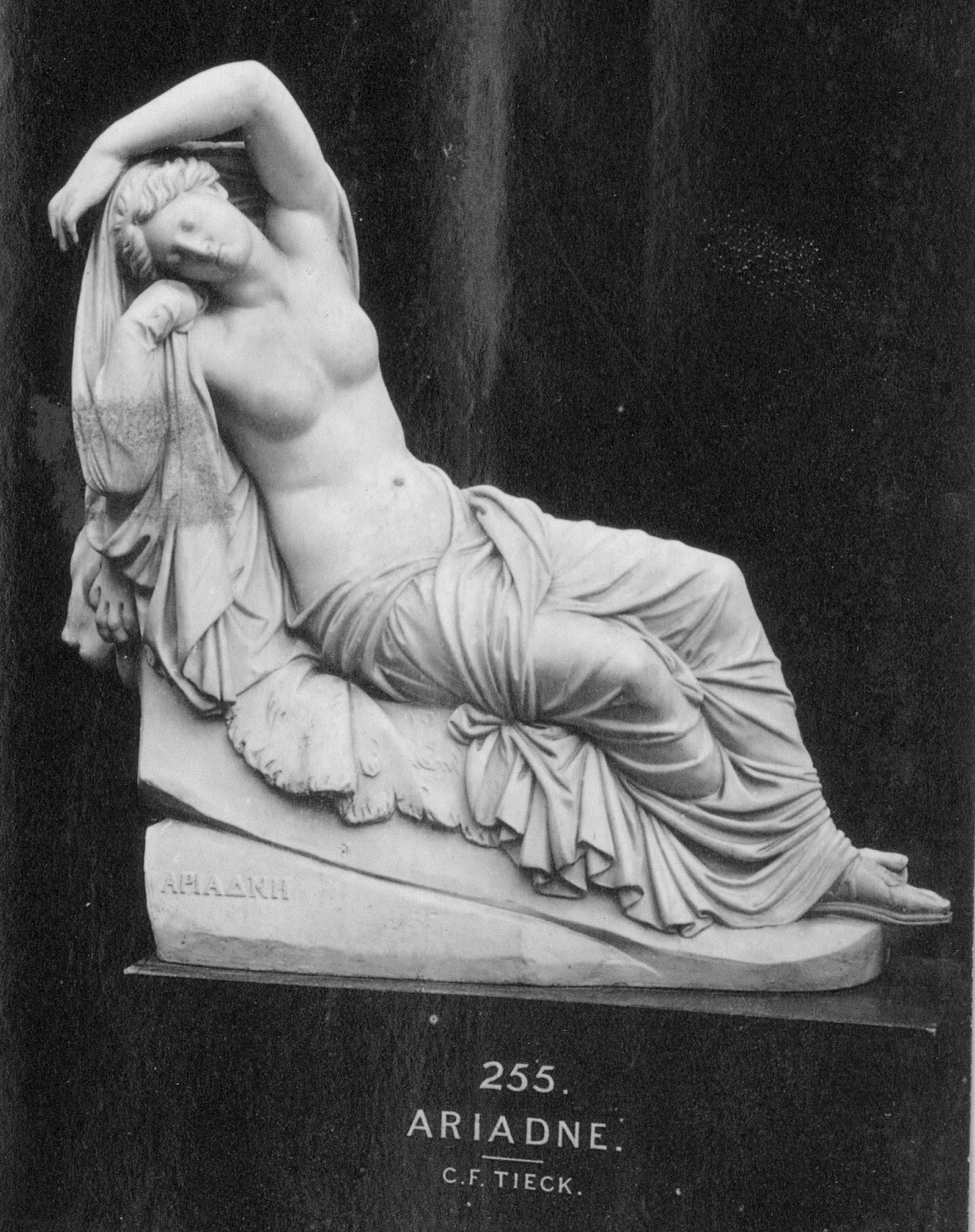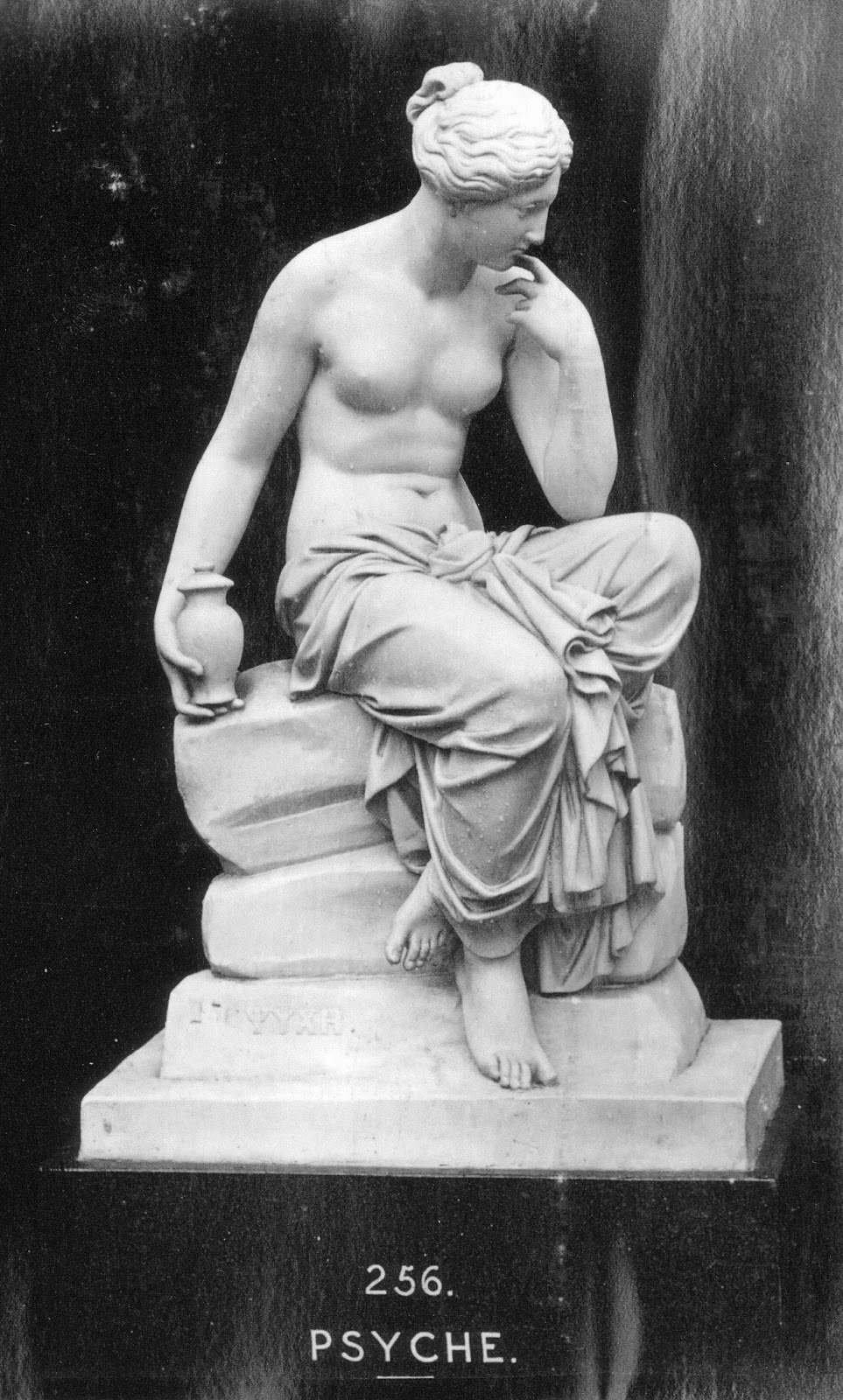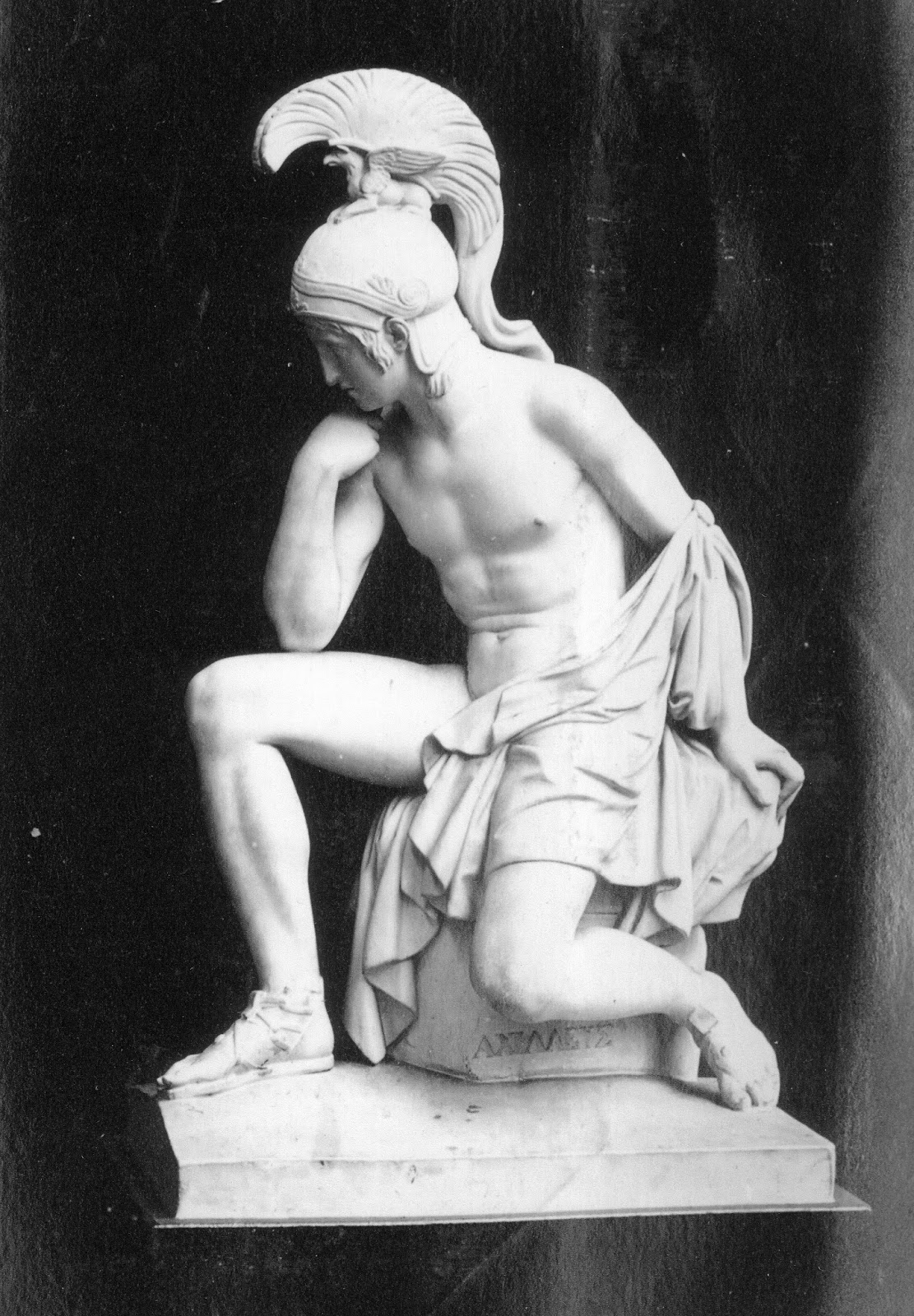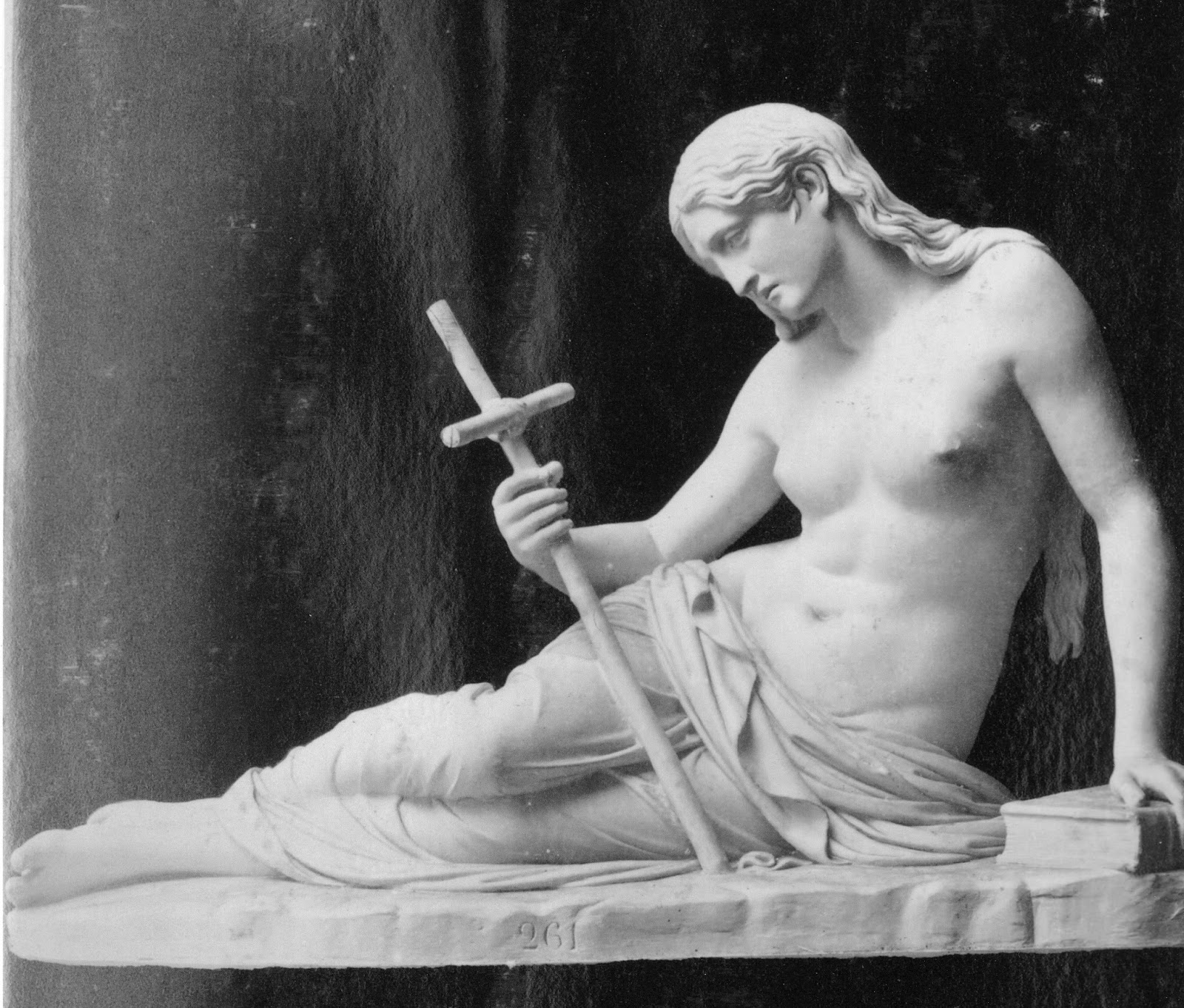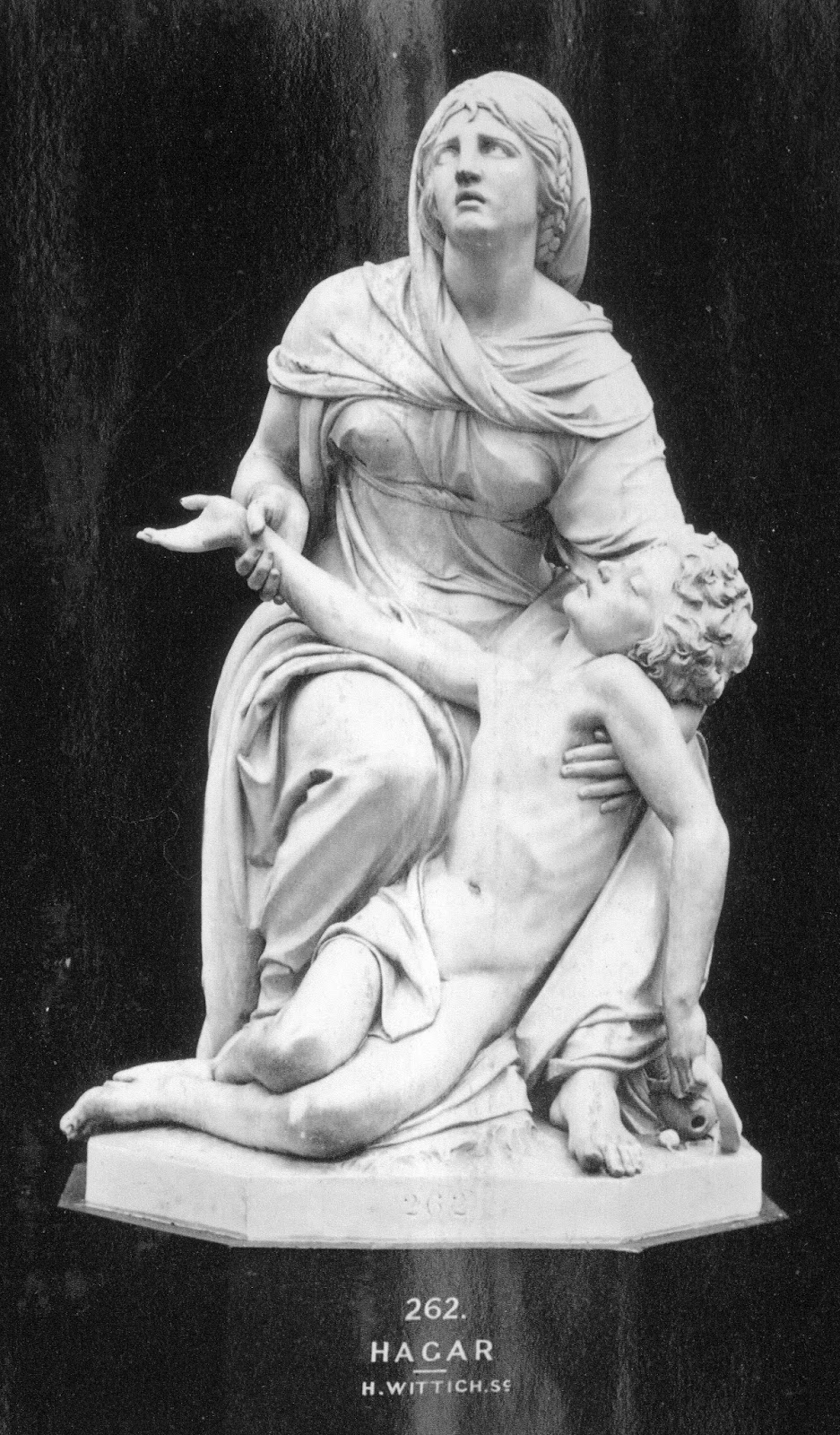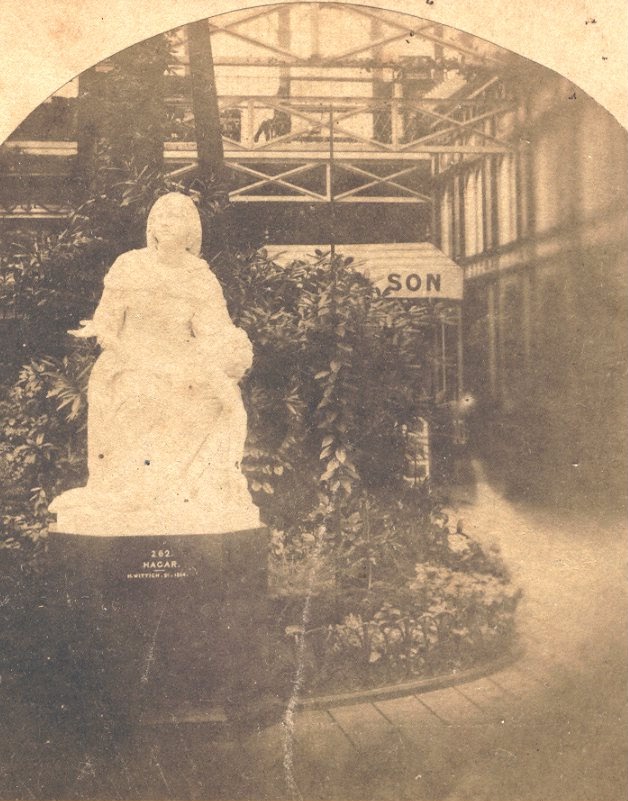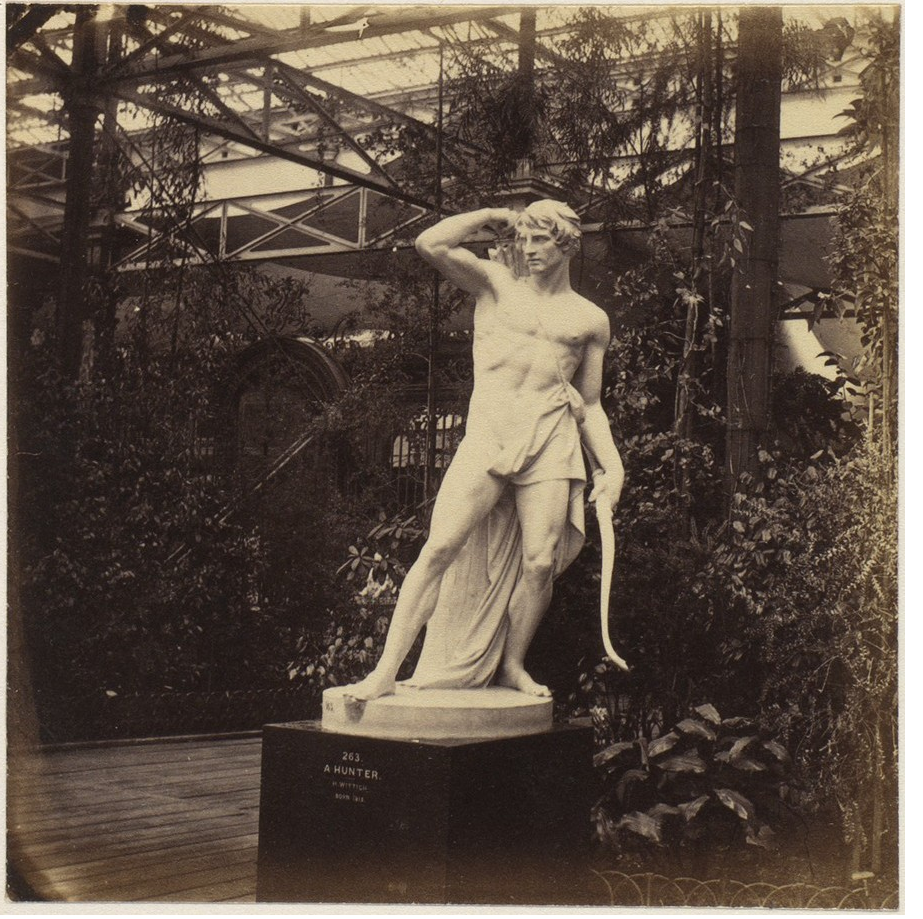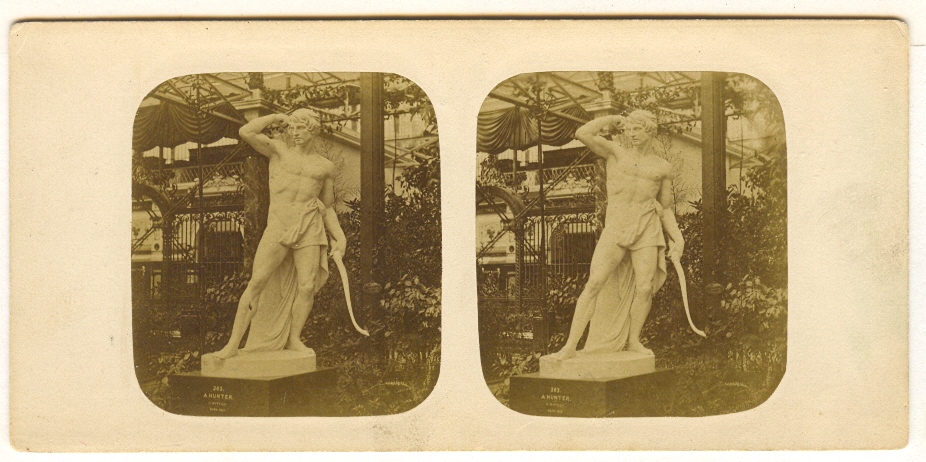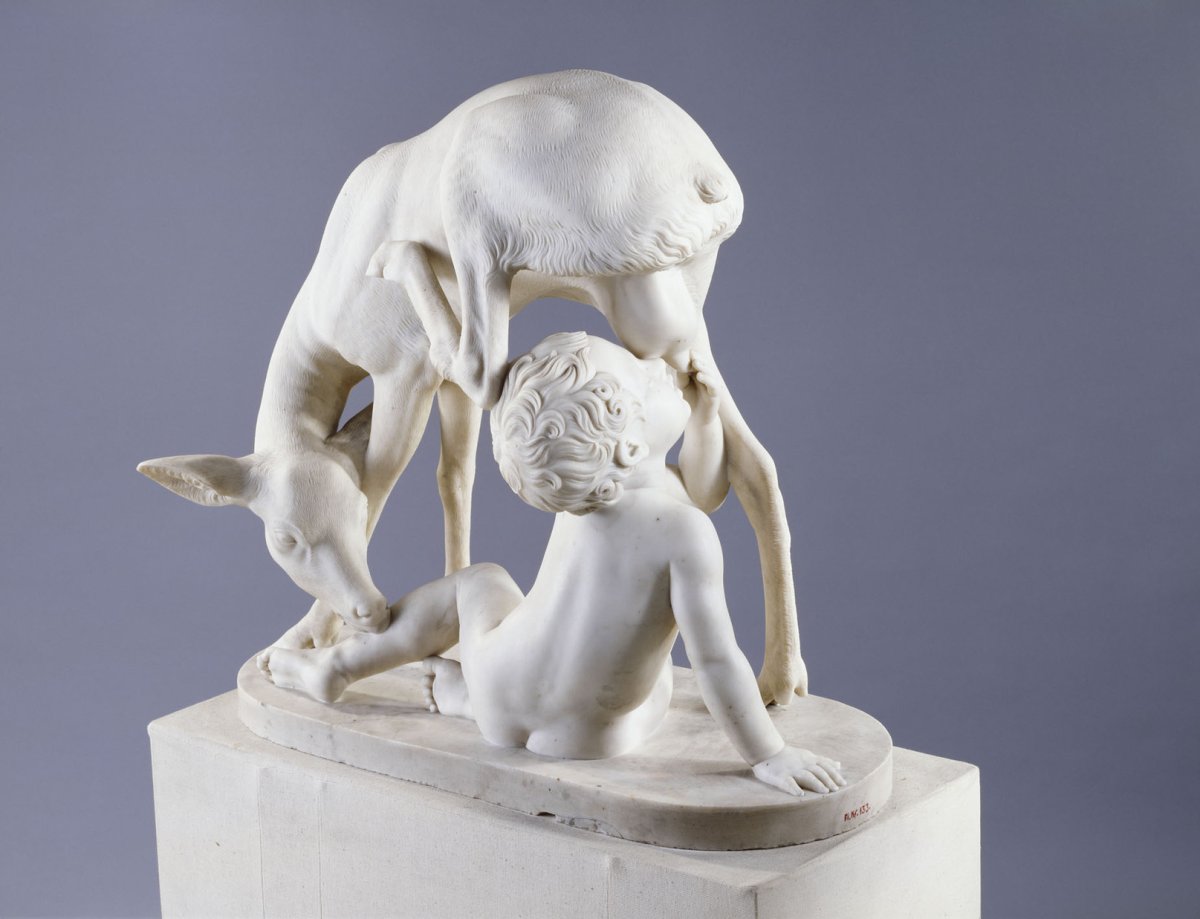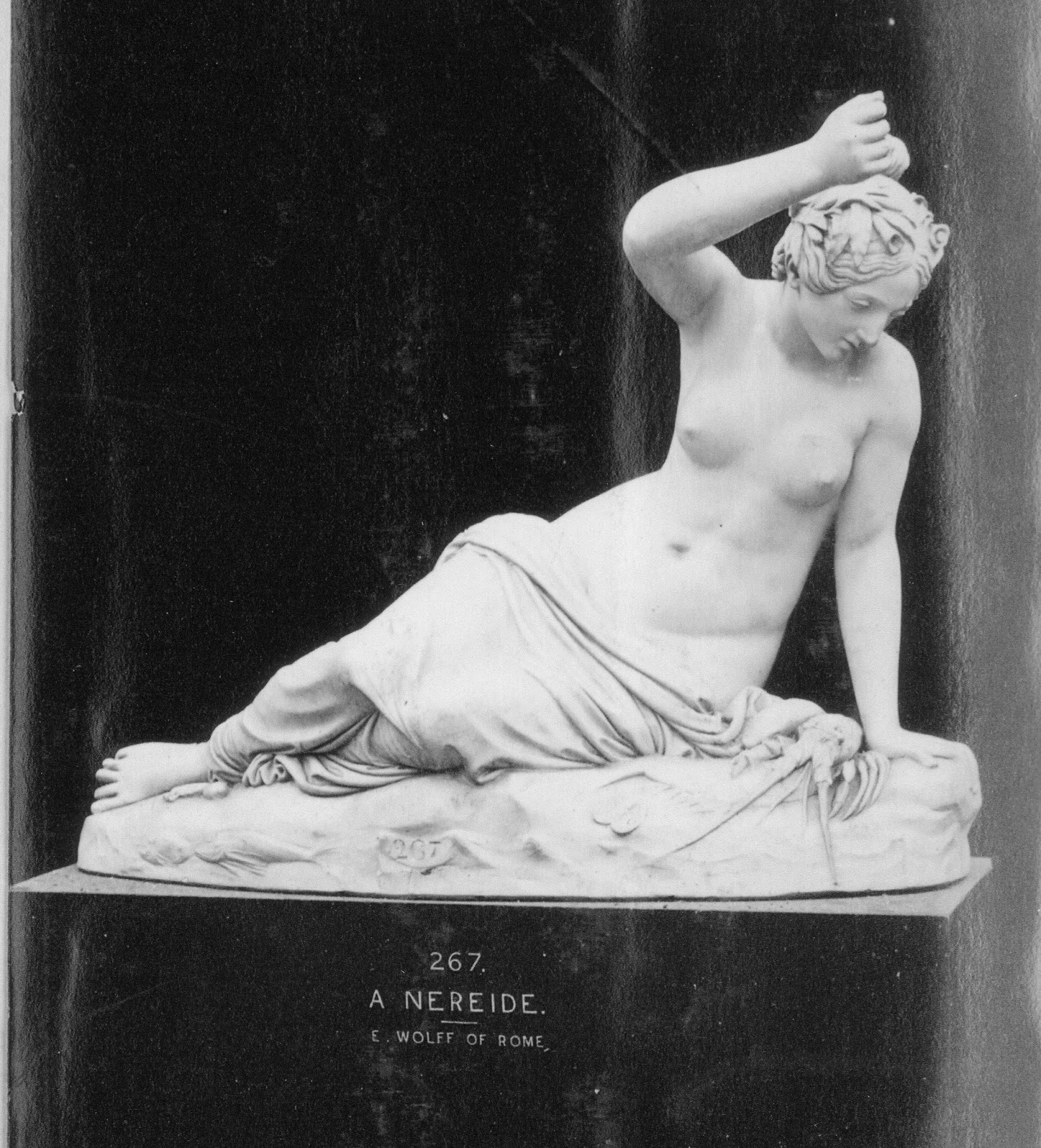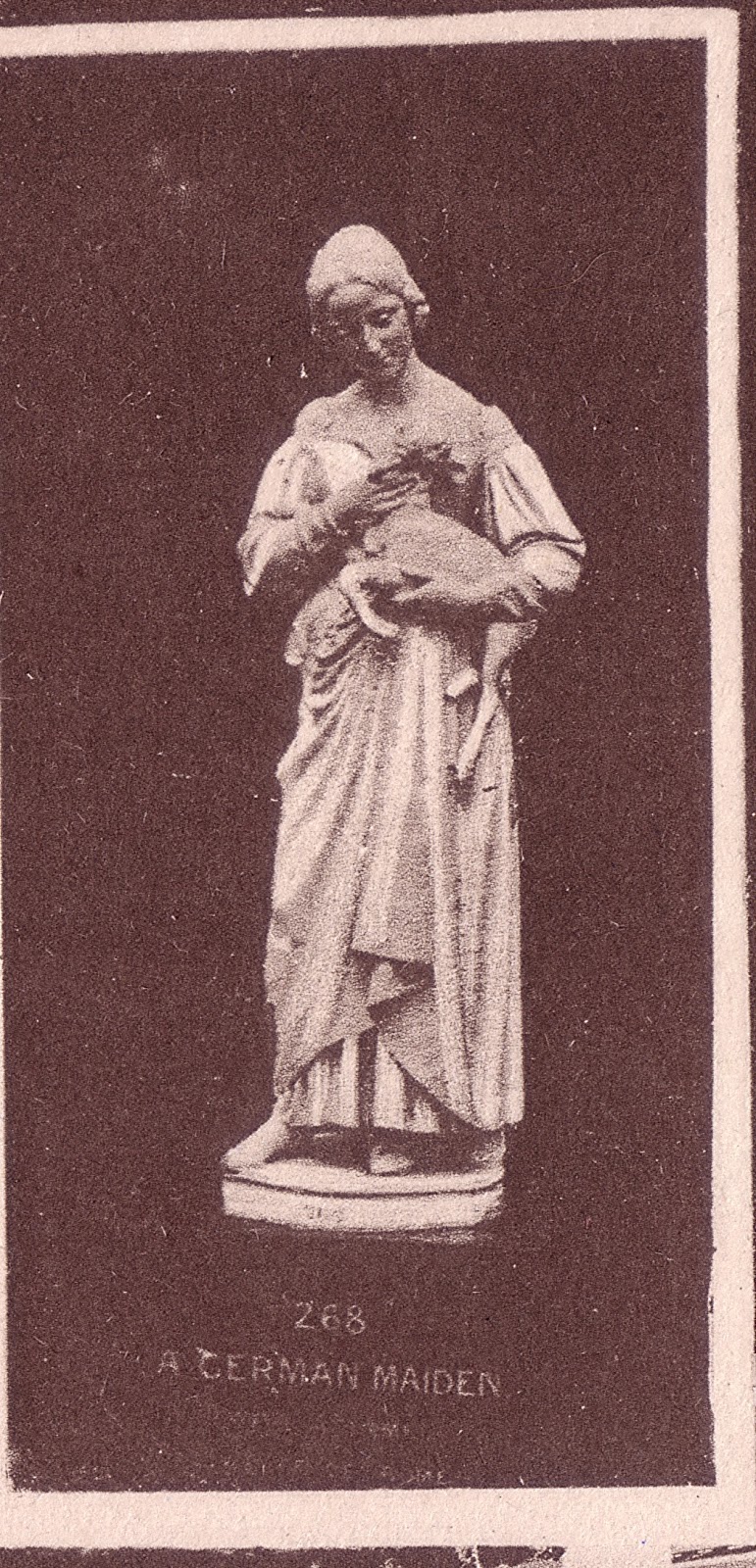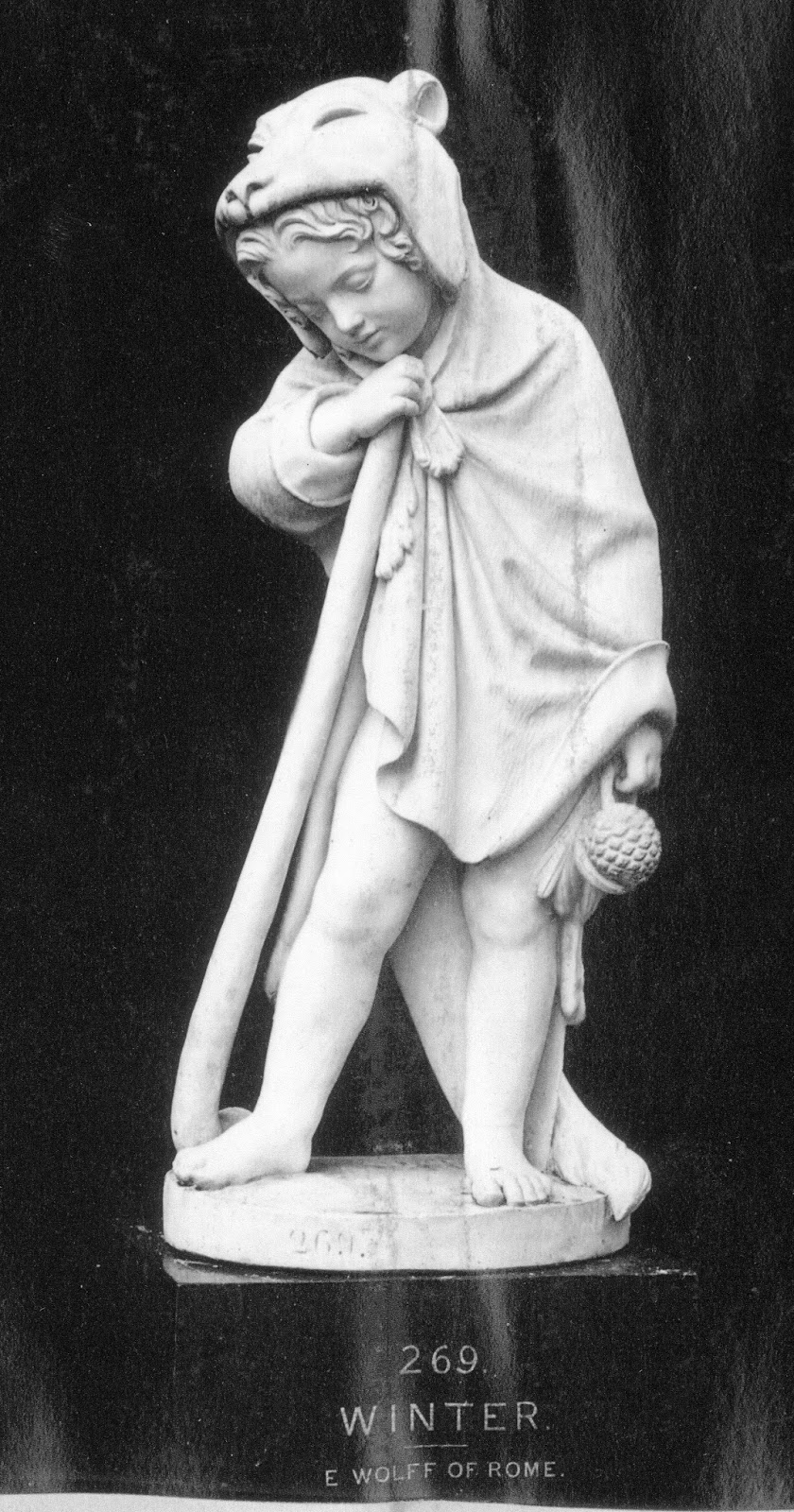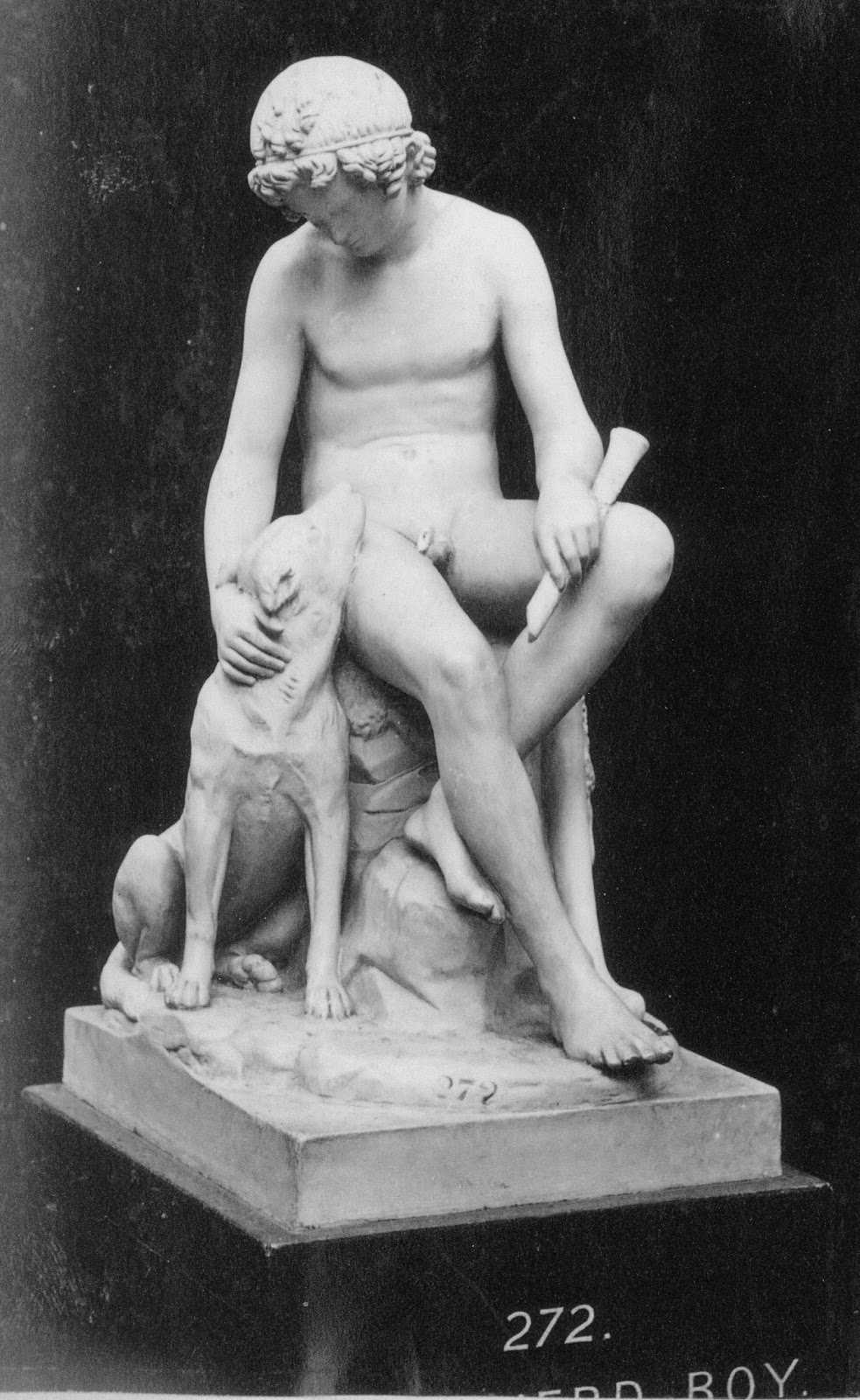BERTEL THORWALDSEN.
1770 - 1844
Albert, or, as he was called in his own country, BERTEL THORWALDSEN, was born at Copenhagen in 1770. His family was noble: he counted, as we are assured, ancient kings of Denmark and famous Icelandic poets and sages among his remote ancestry; but his parents were so reduced in station and in fortune, that his father (whose trade it was to carve figure-heads for ships) could with difficulty provide for the education of his son. Albert was a quiet, reserved, dreamy, silent boy, supposed to be dull, known to be ignorant, but he was a born artist; and in his father’s workshop he learned at least to use his tools. He was at length sent to the drawing school of the Academy, which he attended for several years, during which he assisted his father, and struggled with poverty and hardship; in 1795 he gained the highest academic prize for a model in bas-relief, which gave him the privilege of being sent to Rome, at the expense of the Academy, with a salary of 300 dollars for three years. He was still, while poetry and art were fermenting within his soul, so ignorant of the commonest elements of literature, that it was necessary to detain him for two years before he could set off. He arrived at Rome in the year 1767, and there he passed a year or more, doing nothing, lost apparently in idle contemplation of the wonders around him, to the great discouragement and almost despair of his friends. In the year 1799 his small pension expired; he was now in his thirtieth year but he had done so little, and the case appeared so hopeless, that he was on the point of returning to Denmark. At this critical moment, a rich Englishman, the well-known Thomas Hope, entered his studio and found there the model of the statue of Jason. He was struck by it, ordered it in marble, and generously laid down more than the price asked for it; Thorwaldsen remained in Rome to study, to work, to reach a height of fame and success which he had, perhaps, silently dreamed of himself, but which no one had anticipated for him; when, thirty-eight years afterwards he revisited his native city of Copenhagen, he was “received among men like a descended god.” He had left Copenhagen an obscure melancholy boy, he returned rich. A frigate was sent to convey him to his native shore, and when he landed, the people drew his carriage in triumph to the city. In 1841, he revisited Rome, collected his property together, and finally returned to Copenhagen in 1842. His long, happy, glorious life was crowned by a death as happy. On taking his accustomed seat each one evening to listen to a musical performance, his head after a while sank on his breast, and he never raised it again. Thus he died at the age of seventy-three. Those who have once seen Thorwaldsen, will not easily forget the handsome old man, with his regular features, his ample brow, his penetrating blue eye, and flowing white hair. Of his merit as an artist there can be but one opinion: his superiority to Canova is now generally admitted. His inventive genius was a s various as it was inexhaustible; and the ease, precision, and facility with which the clay took form under his hands, was often a matter of astonishment to those who stood by: when some observed that he could not chisel the marble with the same certainty that he modelled the clay, he replied laughingly, that if his hands were tied behind him he would bite a statue out of the marble with his teeth. Of his almost innumerable works all are not of course equally good, but no man has left behind so many that may be pronounced excellent. In the management of bas-relief he attained perfection. He was the first among the moderns who felt and applied the principles on which the Greek artists worked in this style, and who understood the widely different laws which regulate the picturesque and the sculptural treatment. In the latter part of his life he devoted himself principally to religious subjects. A few only of his most celebrated productions are here, but sufficient to exhibit the astonishing versatility of his powers. Among his statues, the Shepherd Boy, the Seated Mercury, the Venus with the Apple, have not been surpassed. Of his bas-reliefs the grand frieze of the Triumph of Alexander is perhaps his finest. In these classical compositions he sometimes gave a new and charming significance to the old forms and associations, which entitle him to rank as a born poet. His fancy was always regulated by a pure taste and an elevated moral sentiment. Thorwaldsen executed many busts and portrait statues, but on the whole was not so happy in them as his ideal works. His statue of Lord Byron, for instance, must be pronounced a failure both in the resemblance of the head and in a characteristic treatment; it is a mistake altogether. Nor are his statues of Goethe and Schiller quite satisfactory. The works of Thorwaldsen are scattered all over Europe. Some of his finest are in England, and he never forgot that his first patron had been an Englishman. He died in 1843.

216. HOPE.
Statue. Life size.
This fine statue is a singular conception of the subject, an imitation of the grave Etruscan style. Hope stands before us here pensive rather than joyous; a maiden dignified and modest, with rich and ample drapery, which she raises with her left hand, in act to step forward; while in her right she holds the yet unopened lotus flower.
The model was completed in 1818, and executed in marble for the Baroness von Humboldt (the wife of Wilhelm), in 1829. When she died, a copy, by Tieck, of this statue was by her own desire placed at the head of her grave. It was while occupied with the restoration of the Elgin marbles that Thorwaldsen modelled this statue, and it shows how deeply his imagination had been impressed by the serious and formal style of those remains of early Greek art.
Classical – somewhat archaic in style. (See Greek Court page 20.)
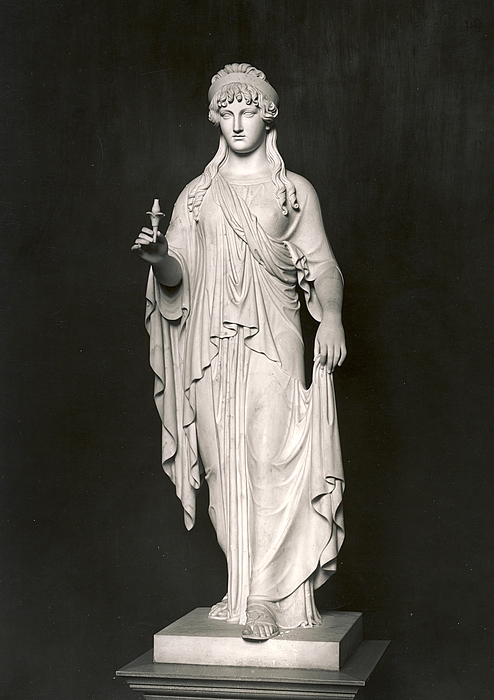
217. VENUS.
Statue. Life size.
Standing, she holds in her right hand the fatal apple decreed to her by Paris; the left rests on her drapery, thrown over the trunk of a tree; she seems to turn to the other goddesses with triumph. This is a very exquisite version of the “Venus Victrix” of the ancients. The first conception was considerably under the size of life. The artist, however, broke the model, and repeated his design of a larger size, in 1816. It was executed in marble, for Lord Lucan, about the year 1824.
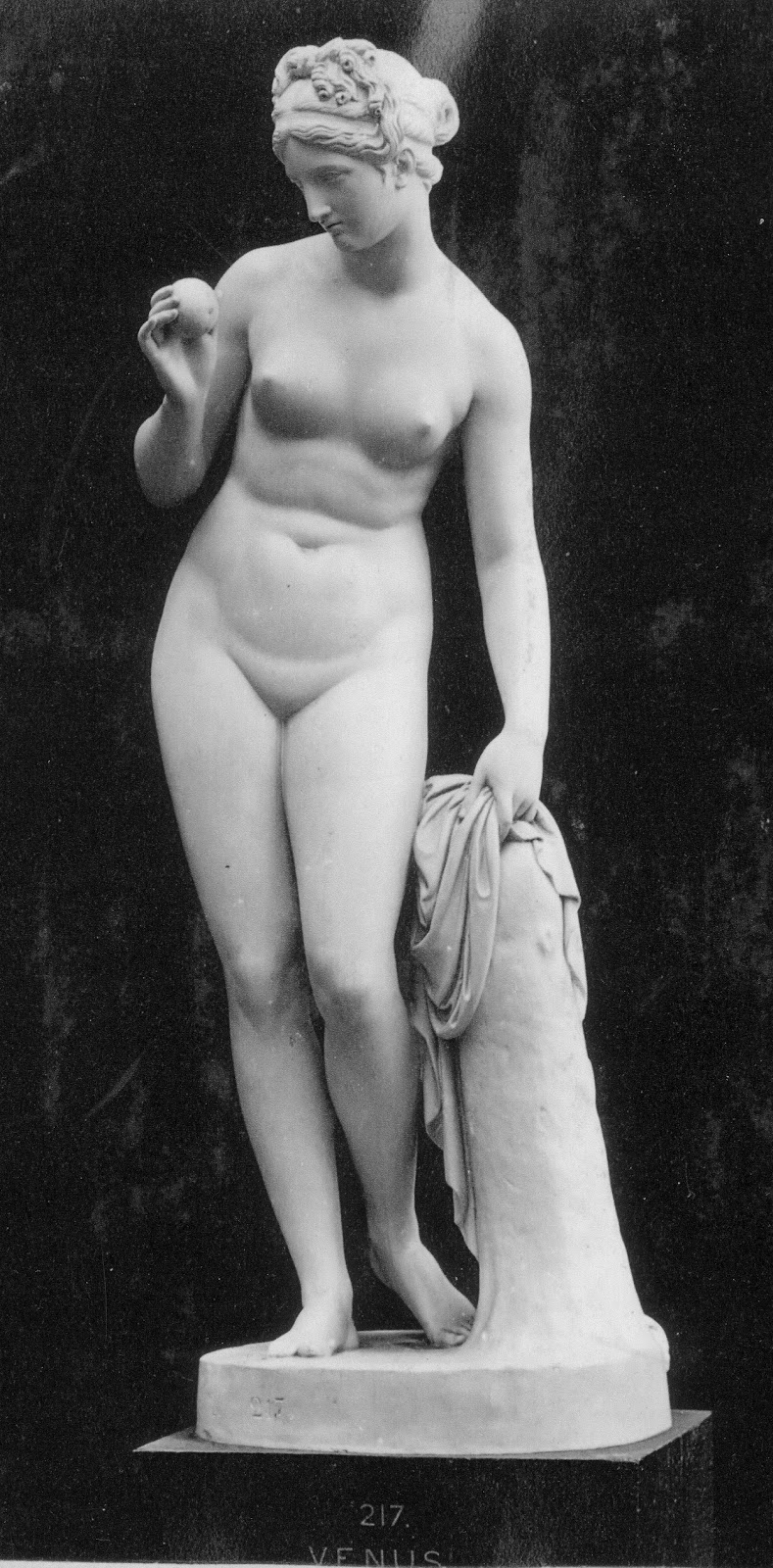
218. VENUS WITH THE APPLE.
Statue. Life size.
This is the same subject as No.217, and the same treatment; but the model has been slightly altered; the leg is less bent, and the turn of the head not quite the same. The alterations however are so trifling, that though they are felt at the first view, it requires a close and careful comparison to appreciate them.

219. MERCURY.
Statue. Life size.
Mercury seated, holds in his left hand the pipe with which he has soothed Argus to sleep; in his right hand he grasps the sword with which to slay him. According to the Greek legend, Argus, with his hundred watchful eyes, was sent by Hera (Juno) to guard Io; Jupiter commissioned his messenger, Mercury, to carry off Io, which he accomplished by putting Argus to sleep with the sound of his pipe, and then cutting off his head. This statue is one of the most perfect productions of modern art which excel it, in the completeness and beauty with which the conception has been carried out. In the action and attitude, the present, the past, and the future moments are exquisitely blended; the god has just taken the reed pipe from his lips, the sounds still float in the air, his head is turned towards the sleeper with a look of suspense, the word is half unsheathed; but the moment, though one of transition, is one of repose; and nothing can exceed the quiet grace of the attitude, and the youthful, god-like beauty of the form. This statue was modelled in 1818. The first marble was executed for the Prince of Augustenburg; the second (a most perfect example) is in the possession of Lord Ashburton, and there are other repetitions.
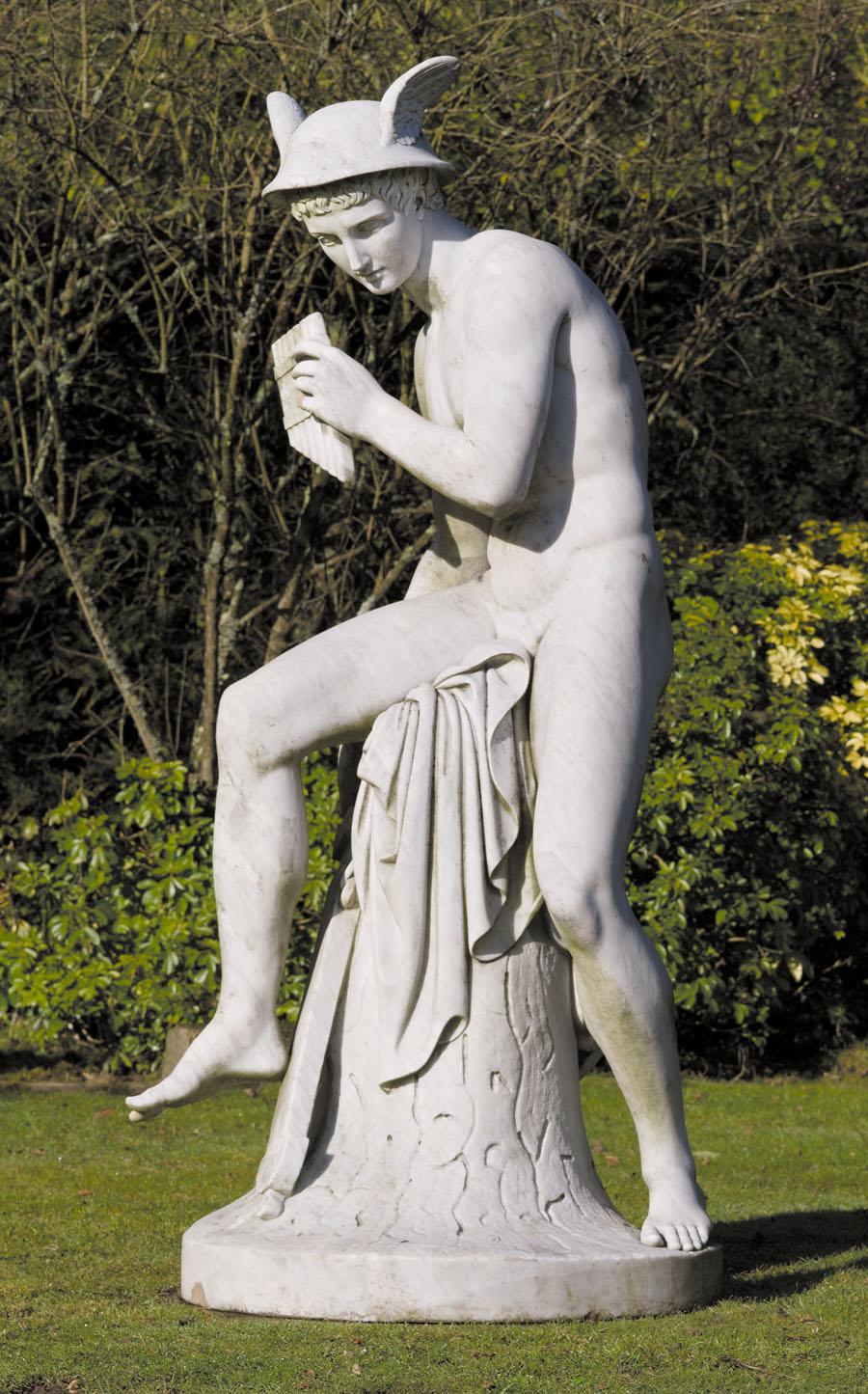
220. GANYMEDE.
Statue. Small life size.
The youthful cup-bearer of the gods holds the cup in the left hand, the vase raised in his right and in the act of pouring out nectar for the gods. He wears the Phrygian cap or bonnet, which, in Greek art, is the usual attribute of the inhabitants of Asia Minor. According to the Greek myth Ganymede was carried off by the Eagle of Jove while keeping his flocks on the plains of Troy.
Classical, and exquisite for true antique feeling and grace.
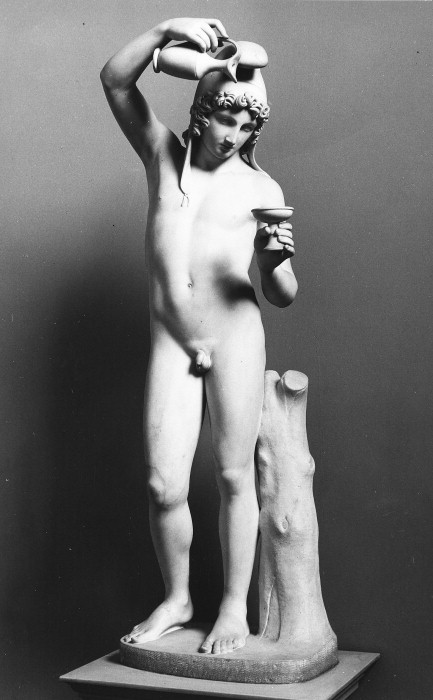
221. A SHEPHERD.
He is seated in an easy attitude of repose, on a fragment of rock, over which is thrown a sheepskin; the right hand is round his leg; with the other he leans on his staff; his dog is at his side. The model for this most beautiful work was a young Shepard of the Campagna. The dog is the portrait of the artist’s favourite dog Teverino.
The original marble was executed about 1817, for Thorwaldsen’s friend Mr. Krause, of Weintrop, near Dresden. A repetition is in the possession of Lord Cowley.
Classical style.
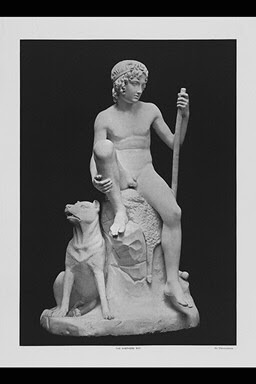
222. THE THREE GRACES.
Aglaia, the eldest of the Graces, half embraces her sisters. Thalia holds the golden arrow of Love, and Euphroyne seems about to feel the point of it. As the three stand, their arms are intertwined with a peculiarly modest and easy grace, and the harmony which unites them is expressed by the little Genius of Love who tunes his lyre at their feet. In this group, Thorwaldsen successfully competed with the well known composition of Canova, then universally celebrated, and as it was thought, not to be surpassed in art. The observer will do well to compare them, as has been done in a famous epigram by the King of Bavaria, who gives the merited palm to the more chaste and throroughly Greek conception of Thorwaldsen. The Graces here are the beautiful beneficent Charites. (See No. 125). The model for this group was completed in 1817, and first executed in marble for the Prince of Augustenburg in 1819.
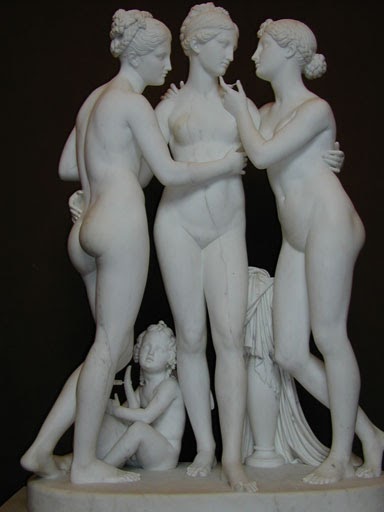
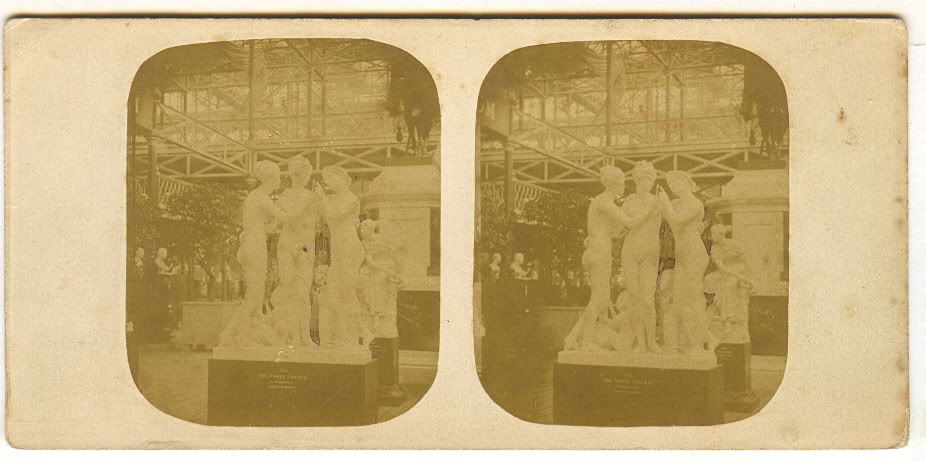
223. LOVE BENDING HIS BOW.
Statue. Small life size.
This is not the divine Eros of the Greeks, but the playful, mischievous Cupid of the Latins, treated in the picturesque style:-
“Qui que tu sois, voici ton maitre;
Il l’est, le fut, ou le doit etre!”
Compare this conception of the deity of love with that of Gibson, N0. 23.
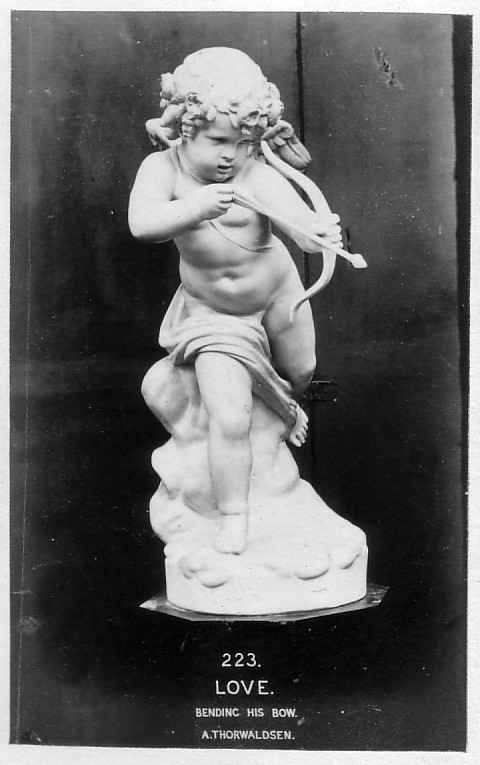
224. A GENIUS SEATED AND PLAYING THE LYRE.
This figure was originally placed at the feet of the three Graces, and has since been often repeated by the artist as a separate statue, being in sentiment very beautiful, and complete in itself.
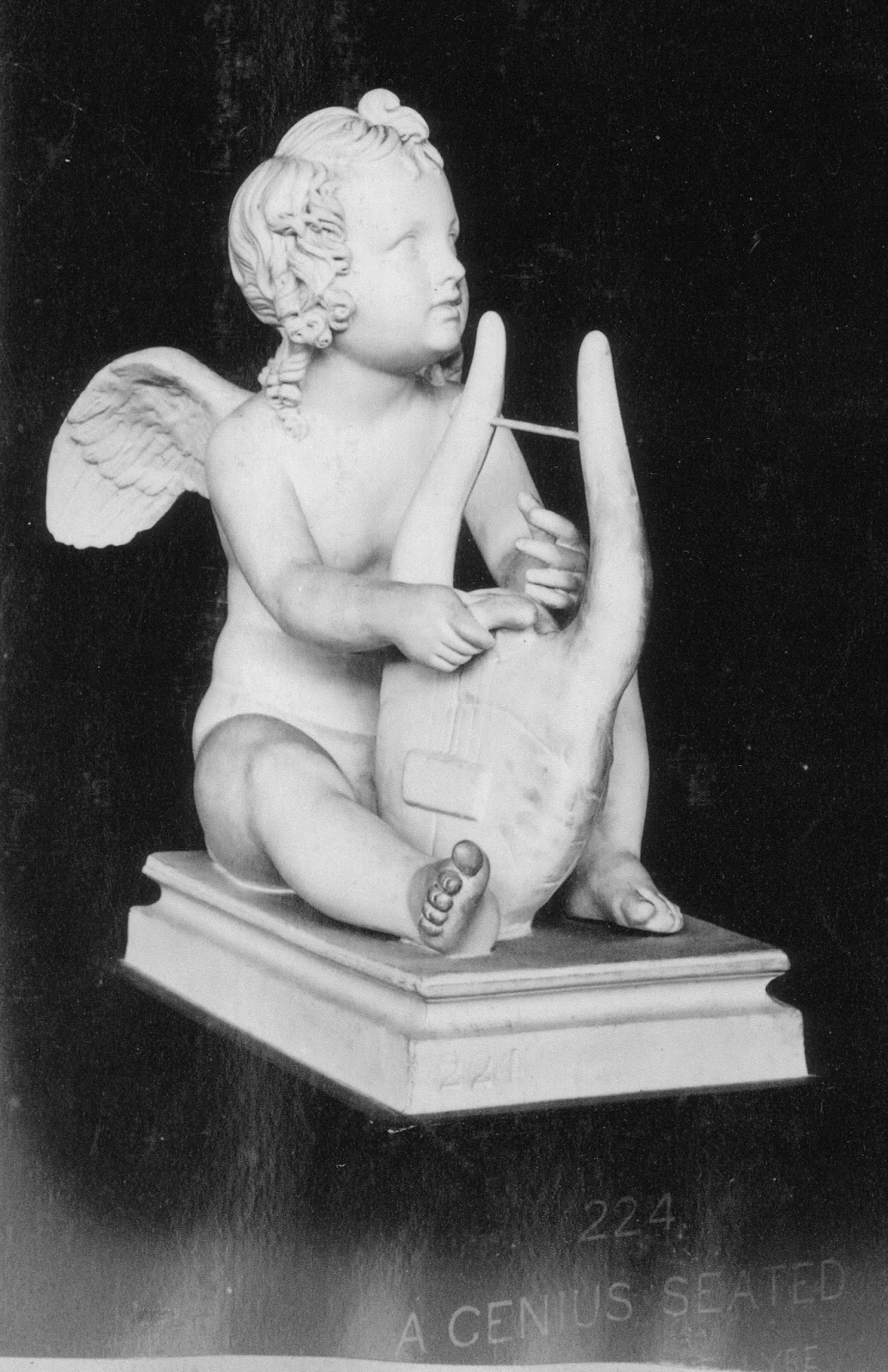
225. A VASE.
With bas-reliefs.
Representing what has been called “the Life of Love” (La linea della vita umana). The subject of this Bas-relief was suggested by a graceful antique picture found in the ruined city of Herculaneum, representing a girl selling Cupids. Thorwaldsen has extended and varied this idea into a very beautiful and significant composition. The maiden is here a winged Psyche; she has a cage near her, full of little Cupids, some of which are peeping through the bars of the cage, others trying to escape: a child behind Psyche lifts up the covering of the cage, and peeps to see what is there; while another, a little older, appears half inclined to play with them, though with a suspicion they are not quite so harmless as they seem. Before Psyche kneels a girl, receiving into her open arms the little Cupid which is presented to her: another maiden carries off her purchase, fondly pressed to her bosom: another, who seems already to repent her bargain, holds him by the wings with thoughtful downcast eyes. The next figure is that of a man in the prime of life, seated, while the little god rides triumphant on his shoulders. The last figure is that of an old man, from whom Cupid has escaped, and is flying off with a mocking air, while the other is stretching forth his hand in vain.
This elegant bas-relief was executed in marble, about the year 1825, and is in the possession of Mr. Labouchere. [Pierre Cesar Labouchere]

The Ages of Love.
226. THE TRIUMPH OF ALEXANDER.
Frieze, in Bas-relief. Almost eighty feet long, by one foot ten inches high.
To under all the beauty and interest of this magnificent composition, it is necessary to say a few words of its history. In the year 1812, Napoleon entertained the project of visiting Rome, and ordered that the Pope's Palace [Quirnal Palace], on Monte Cavallo, should be prepared for his reception, and furnished and decorated as an imperial residence. One of the halls of reception was to be ornamented by a frieze running round the upper part of the wall, and the commision was given to Thorwaldsen, who had only three months to complete his work. As a significant compliment to Napoleon, he chose for his subject "The Triumphal Entrance of Alexander the Great into Babylon." The whole composition, though forming altogether an harmonius and connected deries, may be divided into two parts, meeting in the centre. The procession on the right represents Alexander and his Greeks approaching the gates of Babylon. The procession on the left represents the inhabitants of the conquered city going forth to meet them.
A. First appears Alexander, on his triumphant car, drawn by four horses. Victory at his side, holds the reins.

B. The car is followed by a two armour-bearers, carrying the shield, bow, and lance, of the hero. Then Alexander's famous horse, Bucephalus, prancing and rearing, and attended by two grooms, who are endeavouring to rein him in.

C. Three of Alexander's favourite generals, Antipater, Perdiccas, and antigenus, on horseback.

Returning to the centre. The first figure on the left is the Genius of Peace, who approaches to meet and welcome the conqueror. The Governor of Babylon and his five children follow as supplicants.

G. Next appear three graceful female figures of women, strewing flowers, and a child with a basket on his head.

In contemplating this frieze, which is one of the most celebrated works of the sculptor, in a department of his art in which he excelled, that of bas-relief, we are struck by tow things;- first, the exceeding beauty of the composition, in which, without and crowding or confusion, or unnecessary figures, all the circumstances and sentiments of the scene are expressed with the most vivid truth, yet with the ideal treatment proper to sculpture. Secondly, we cannot but feel that the choice of the subject had a fitness which the artist did not contemplate. Alexander entered Babylon to meet his death; this was his last triumph. Napoleon, in whose honour the work was executed, was then setting out on his Russian expedition, which resulted in his downfall; he had seen the last of his triumphs. It is curious, also, that, notwithstanding the totally different style of treatment, we are struck by a resemblance to the processions in the newly discovered Nineveh sculptures, where we see a conquering despot, riding in his chariot, attended by the Genius of Victory, while slaves and captives, and spoils, and strange animals, with their keepers, figure conspicuously. the first cast of this frieze in plaster still decorates the Pope's Palace on Monte Cavallo, though now unfitted for the loclity. It has twice been executed in marble, once for the Palace of the King of Denmark, at Copenhagen (in 1829); and again for Count Somavaria, for which he paid 100,000 francs. [villa Carlotta]
227. NAPOLEON.
Colossal Bust.
As Victor, crowned with laurel. The eagle wings in front, the palm behind, and the cannon ball, are all in questionable taste.
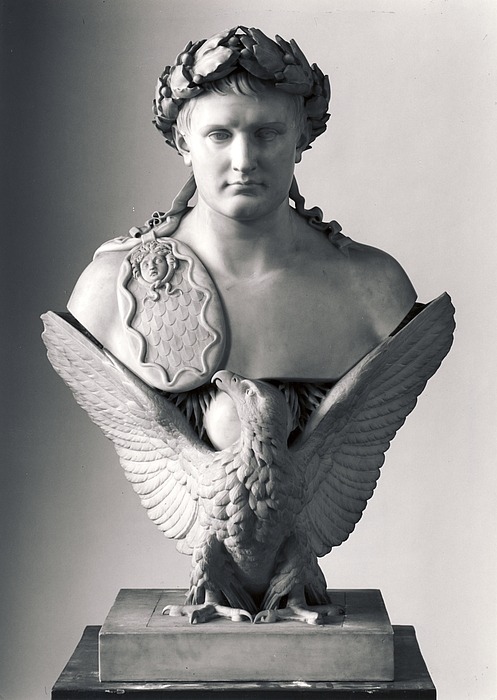
228. LORD BYRON.
Bust.
Feeble, almost ignoble, and without likeness or character.
Of these two busts I must remark, that neither Napoleon nor Lord Byron ever sat to Thorwaldsen. (See Portrait Gallery, Nos. 311 and 418.)
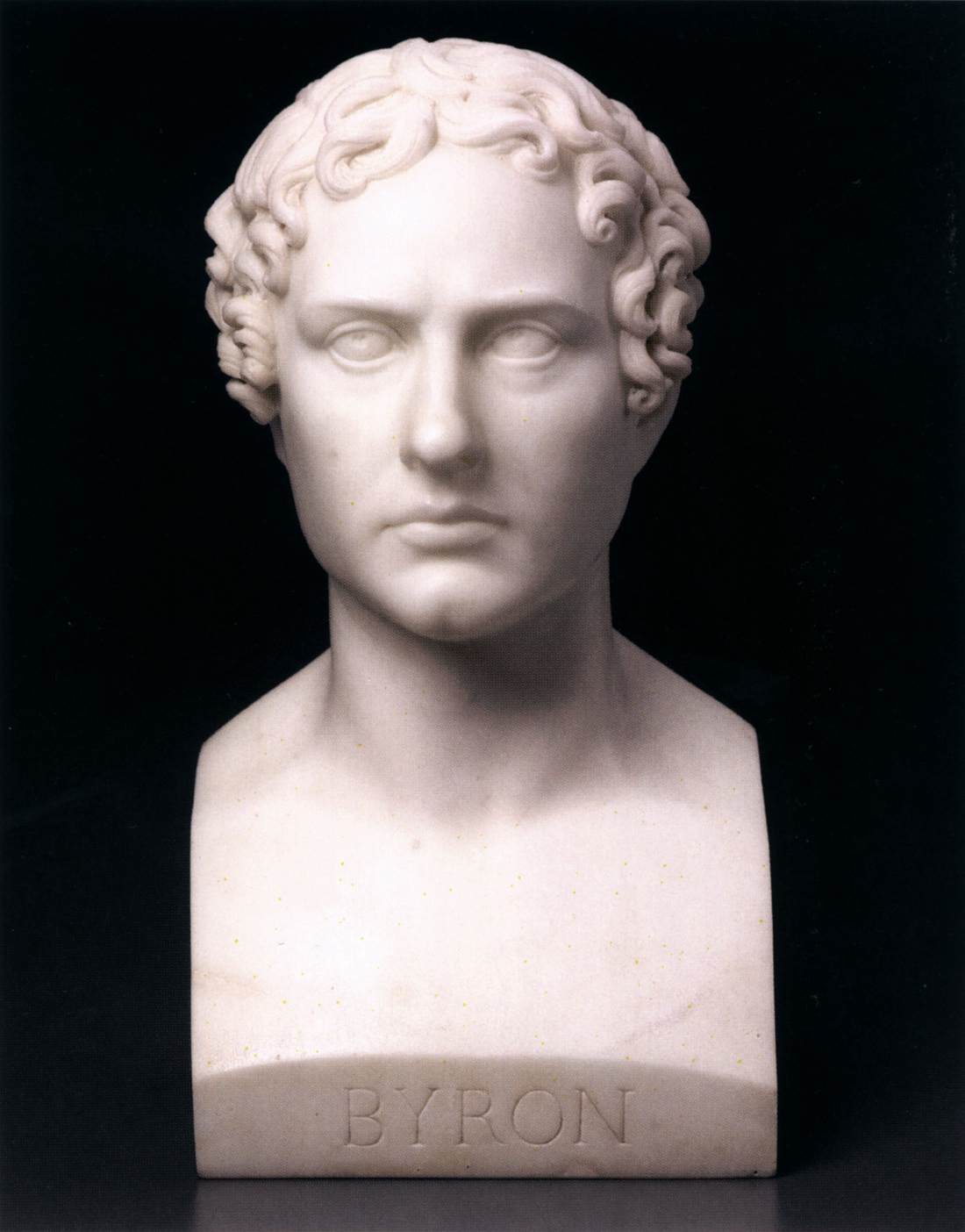
229. MINERVA ADJUDGES THE ARMOUR OF ACHILLES TO ULYSSES.
Bas-relief. Six figures.
After the death of Achilles in the Trojan War, Ulysses and Ajax contended for the honour of inheriting his arms; by the advice of athena (Minerva), they were adjudged by Agamemnon, not to Ajax, the strong man, but to Ulysses, the wise man, in which it must be owned Athena showed some partiality to her favourite; in consequence of this decision, Ajax was seized with madness and slew himself. The subject is taken from Sophocles. Classical style.

230. APOLLO PLAYING TO THE GRACES AND THE MUSES.
Bas-relief. Thirteen figures.
Apollo (he is here in his character of Musagetes) is seated on the left, playing on his lyre; the three Graces, standing on an eminence mutually embracing, appear to listen. In front of apollo, Euterpe, the Muse of lyric poetry, plays on the double pipe. Terpsichore, the Muse of dance and song, sounds the tambourine; and Erato, the Muse who inspired love songs, crowned with flowers, appears behind. The other Muses, Calliope, Clio, Melpomene, Polyhymnia, Urania, Thalia, join in the dance. (To dance at the festivals of the gods was one of the occupations of the Muses; and according to Pindar, the Graces were enthroned on Olympus, next to Apollo.)
Classical style.
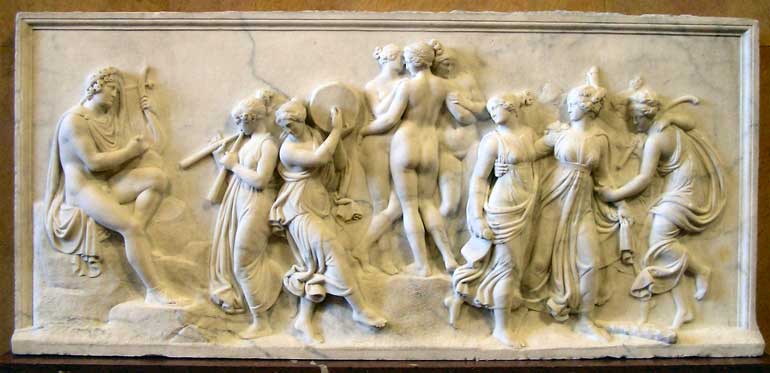
231. THE FOUR SEASONS.
Four circular Bas-reliefs.
A. SPRING, a female figure, attended by two genii bearing baskets of flowers.
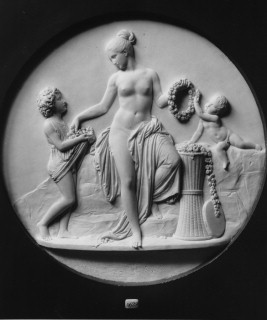
B. SUMMER, a harvest scene, with a group of reapers.
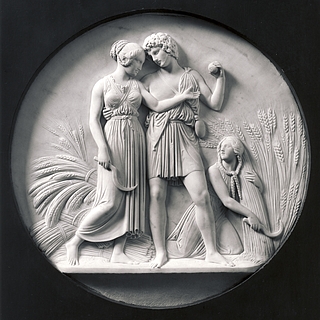
C. AUTUMN, a hunter returns to his home bearing game; a woman and a child (seated under a vine loaded with grapes) receive him.
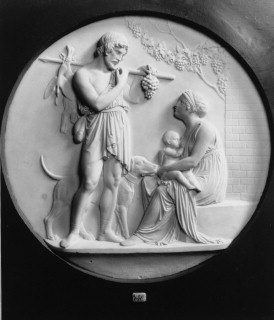
D. WINTER, an old man warming his hands over a brazier, while an old woman lights her lamp.
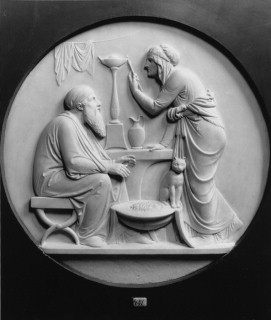
232. THE GENIUS OF THE NEW YEAR.
Circular Bas-relief.
A winged figure expressing the attributes of the four seasons; he has skates to his feet, and bears a bunch of grapes, a sickle and ears of wheat, and a wreath of flowers; around him, in a circle, the twelve signs of the zodiac.
Classical- somewhat picturesque treatment.

233. CUPID AND HYMEN.
Bas-relief.
Love holds the distaff; Hymen spins the thread.

235. CUPID AND PSYCHE.
Bas-relief.
Flying or floating through the air.

237. CUPID BOUND BY THE GRACES.
Bas-relief.
The three Graces, seated, bind Cupid with garlands of flowers, having first stolen his arms. A very charming and significant allegory; classical treatment.
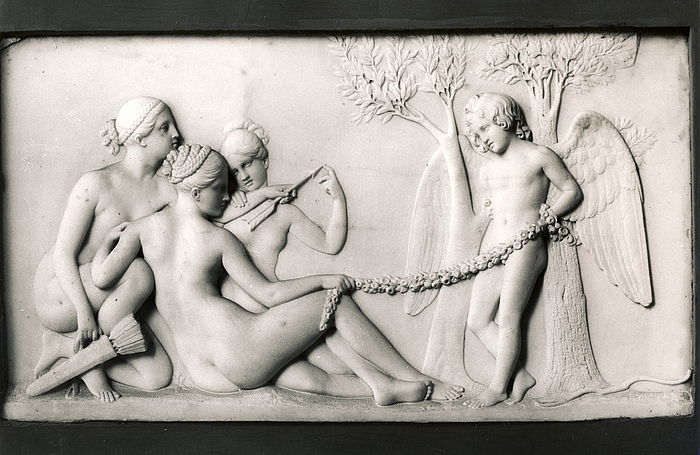
238. THE BIRTH OF BACCHUS.
Bas-relief.

240. LOVE MAKING HIS NETS.
Bas-relief.

242. THE FOUR ELEMENTS.
Bas-relief.
A. AIR bestrides the Eagle, and is armed with the thunder.
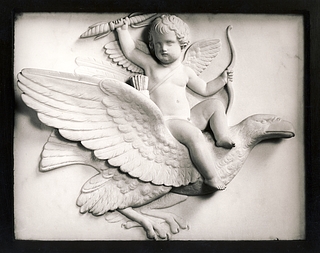
B. EARTH guides the lion.
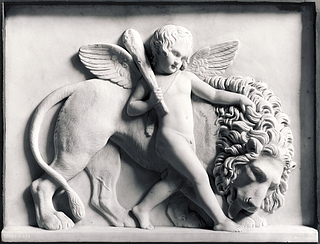
C. WATER, bearing the trident of Neptune, is borne by a dolphin.

D. FIRE, having yoked Cerebrus (who guarded the flaming gates of Tartarus), drives him with the fork of Pluto.

Elegant and classical, yet somewhat conventional in treatment.

244. LOVE AWAKENING PSYCHE.
Bas-relief.
She has swooned, after opening the casket entrusted to her by Proserpine. Love takes an arrow from his quiver, with which to recall her to life.

245. THE BAPTISM OF CHRIST.
Bas-relief.
Two figures only; the Redeemer stands of the water, with hands meekly folded on his breast. St. John holds the shell.
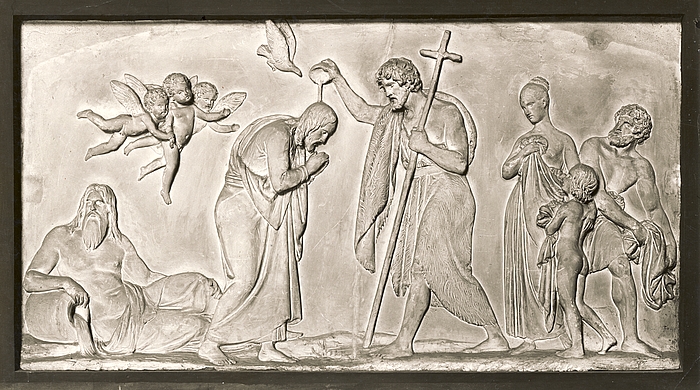
246. A GUARDIAN ANGEL.
Bas-relief.
The angel directing and protecting the steps of a child.
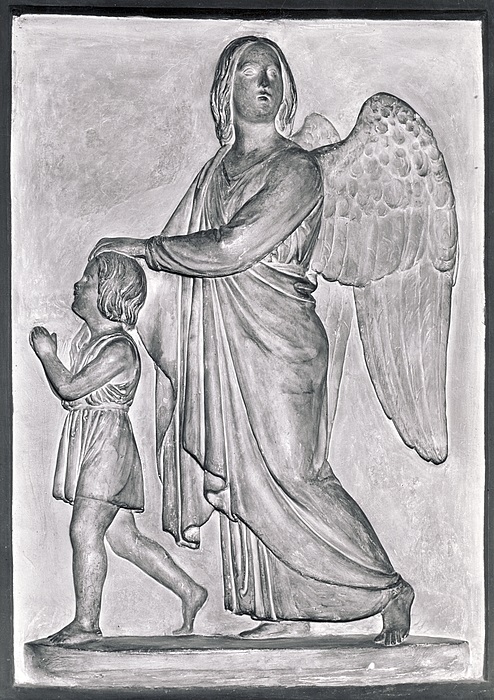
247. THREE SINGING ANGELS.
Bas-relief.
Gracefully grouped, and singing from the same music-scroll.

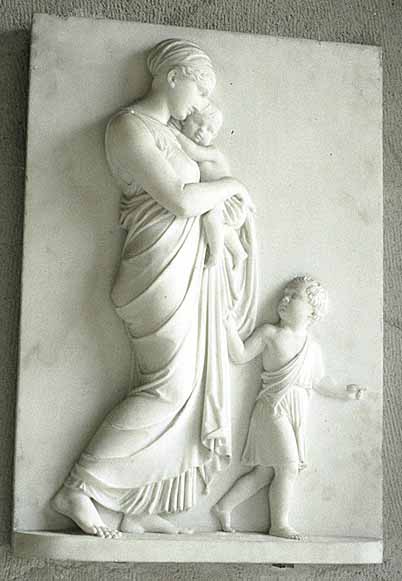
251. CHRIST BLESSING CHILDREN.
Bas-relief.
One of the late religious works executed by the artist after his return to Denmark, about the year 1840.
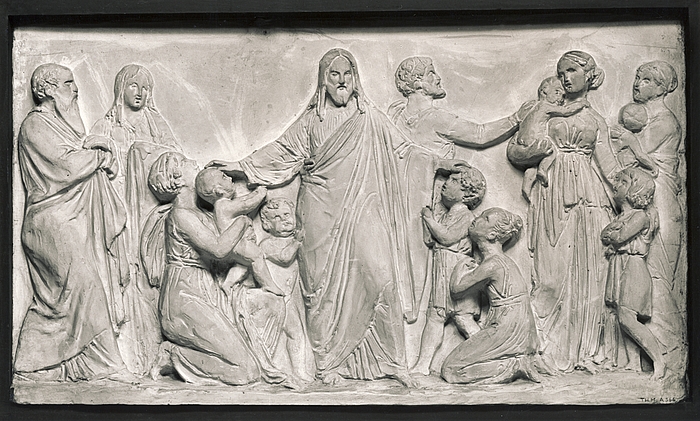
252. THE VIRGIN WITH THE INFANT CHRIST AND ST.JOHN.
Bas-relief.
A Holy Family, somewhat cold and formal.
